
 Jeff Sundin "Winnie Walleye Updates + Reader Questions" September 30, 2022
Jeff Sundin "Winnie Walleye Updates + Reader Questions" September 30, 2022
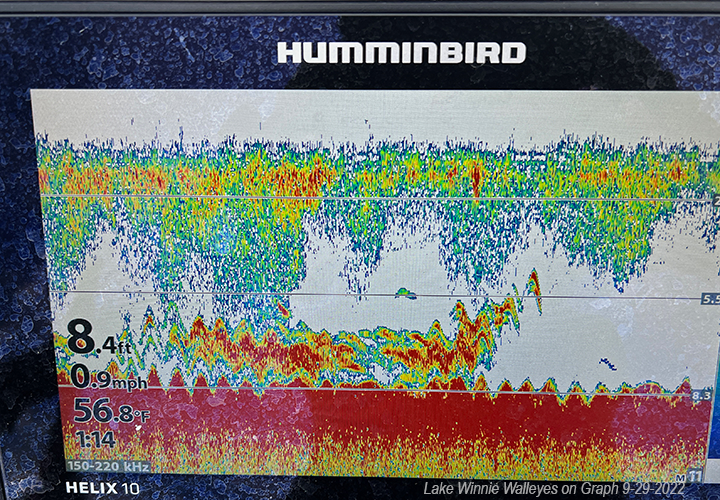 In terms of a current fishing report from Winnie, Bowen’s fishing report posted (September 29, 2022) is good, and the information remains accurate today, so I won’t re-hash the whole thing.
In terms of a current fishing report from Winnie, Bowen’s fishing report posted (September 29, 2022) is good, and the information remains accurate today, so I won’t re-hash the whole thing.
Summing up the fishing conditions from Thursday, surface water temperatures were locked in at about 57 degrees, varrying spot-to-spot by a few tenths + or -. The winds were from the southeast and strong, so fish activity in shallow, wavy water was robust. For me, 7 feet of water was the sweet zone, but we caught a few fish deeper, out to about 8 feet of water.
Jigs and minnows were the only presentation we used, and even with fast drifting speeds of .8 to 1.1 MPH, 1/16-ounce Lindy Live Bait Jigs were used to help our offering run cleaner. The hairy grass mentioned in Bowen’s report yesterday is growing all over the south, west and north sides of the lake. It’s not impossible to use heavier jigs, but it is a lot less fun because even the 1/8-ounce size gets fouled up on almost every cast. Like I told Ken while we were fishing on Wednesday , “it’s hard to say for sure if the light weight jigs are helping us catch more fish, but they definitely are not holding us back either, they have been very productive.
Perch began really showing up on Wednesday and Thursday too. Recent reports often mention catching low numbers of larger fish. Since the water temperatures have dropped, there are now larger numbers of smaller fish on the prowl. We caught dozens of perch in the 8-to-9-inch range yesterday, with only a dozen fish crossing the 10-inch line on my ruler. So, at the end of the day, the harvest was identical to most recent trips, but we caught a lot more fish along the way.
With plenty of current news about Winnibigoshish on the pages already, I want to ue my morning writing time to tackle another important topic that came inf the form of this reader question.
 September 30, 2022 — "Winnibigoshish Walleyes and Voluntary Size Restrictions"
September 30, 2022 — "Winnibigoshish Walleyes and Voluntary Size Restrictions"
On September 29, 2022, Roy Rasmussen wrote, Q) “I read your comments about walleye fishing on Lake Winnibigosh and the “slot limit” that you’ve imposed on yourself. 1st, I wonder how your fishing customers respond to the self-restriction? 2nd, it sounds like a great idea, but I’m interested to know how it’s really been working in daily practice?
A) Roy, thank you for the thoughtful questions, I really appreciate them. In addition to an opportunity to discuss my philosophy about fish harvesting, they also provide a platform for discussion about what the walleye population, from an observer’s point of view, looks like in Winnie right now.
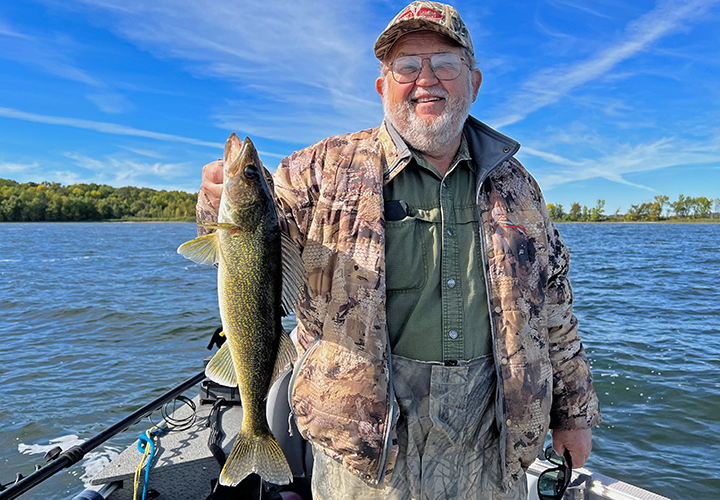 Regarding customer reaction to “voluntary” self-imposed size restrictions, they are generally good. When you think about it, most customers are looking to their fishing guides for advice about what to keep, and what not to keep. So, when my customers believe that they can release a bunch of smaller walleyes at the same time they can “hold-out” for some larger ones, they’ll gladly participate.
Regarding customer reaction to “voluntary” self-imposed size restrictions, they are generally good. When you think about it, most customers are looking to their fishing guides for advice about what to keep, and what not to keep. So, when my customers believe that they can release a bunch of smaller walleyes at the same time they can “hold-out” for some larger ones, they’ll gladly participate.
That said, most customers do want to harvest some fish, so they’re not going to wait all day long, releasing everything they catch just hoping for a nicer fish or two to swim along. That’s where the customer service part of guiding comes into play. It’s on me to “read the room” and provide guidance that is tailored to everyone, or group that I fish with.
Take Wednesday for example, fishing with(photo left) Ken Seufert, alone and knowing that we had not only Wednesday, but 2 more days after that to fish as well, we could afford to be highly selective. That day, we closely adhered to a voluntary 16 inch minimum and on that day, came very close to making it. I think it was about 3:00 PM when we had 4 fish between 16 and 18 inches in the livewell. Knowing he and his wife would be eating some fish on Thursday, I relaxed the standard a little bit, harvesting 2 more fish that were 15-1/2 inches. Along the way, we caught lots of small fish, and a couple of larger fish in the protected slot; it worked out well.
On Thursday, there was a whole new dynamic, I fished with 3 hungry men who happen to place a great deal of emphasis on how many fish they can get. I started the day advising that we follow a lower, 15 inch minimum standard and they followed that guidance to a T. I think it was about 2:30 when we had 12 of their possible combined 18 fish limit in the livewell. Knowing they planned a fish fry at day’s end, I relaxed the standard, suggesting that we better harvest a few 14-inch fish to round out the creel. As it happened, a few of the fish we caught afterward were still above the 15-inch target, so we actually only harvested 2, maybe 3, 14-inch walleyes.
Now the fish were biting that day and I can’t tell you how many times we could have harvested 3 quick limits by simply “keeping” everything over 14 inches. That would have made my day easier, shorter too maybe. But the way I look at it, the trade off for an easy day today might be a tough day next year, or the year after that. However, many of the smaller, 2019-year class fish we release now, will still be there to provide opportunity later, possibly at a time when my fellow anglers and I really need them.
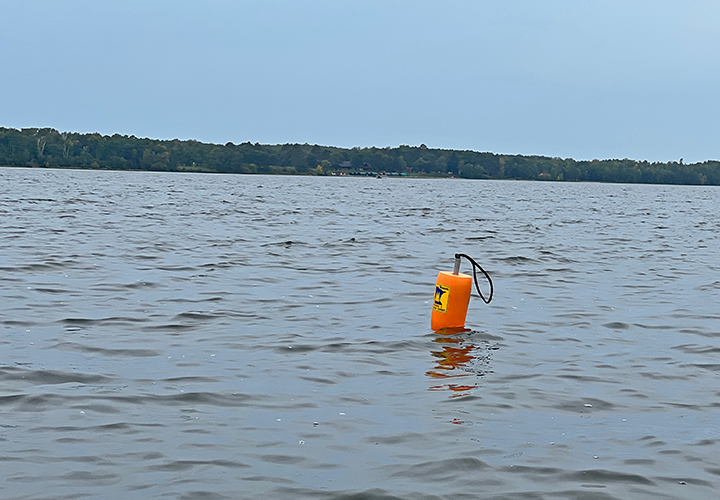 Another nuance that enters the picture soon will be the maturation of fish from the plentiful 2018-year class. Those fish have already grown to sizes more than 16 inches, many of them are 17 inches and some, (we’ve caught 13 so far this fall), are already over 18 inches and now within the protected slot size.
Another nuance that enters the picture soon will be the maturation of fish from the plentiful 2018-year class. Those fish have already grown to sizes more than 16 inches, many of them are 17 inches and some, (we’ve caught 13 so far this fall), are already over 18 inches and now within the protected slot size.
I remember all too well, the years when Lake Winnie anglers grumbled incessantly about catching only slot-fish, and not being able to harvest anything. So, the way I see it, we’re headed for another bubble like that, a time when the lake has an abundance of larger fish living in protective custody. If we head off a few of those fish now, instead of harvesting the smaller, 2019-year class fish, then there will be another season, maybe more, of seeing lots of happy faces at the resorts, the bait shops, the restaurants, anyplace that depends on fishing tourism and harvested fish to make a living.
The whole concept of following “voluntary” guidelines is fluid and must be adapted to the circumstances on a day-by-day basis. Before he died, Wayne Schumacher, a longtime friend and sometimes fishing customer used to say, “you just have to take what the lake gives you”. Wayne was right then, and his guidance lives on, some days the lakes give us more than others.
Like I said in the original article Roy, if I find myself in a situation where imposing the voluntary harvest restrictions isn’t working for my customers, and the opportunity to harvest fish from 2019 presents itself, I will adapt! On a given day, I may see the need to temporarily lower size standards when it’s in the best interest of my customers.
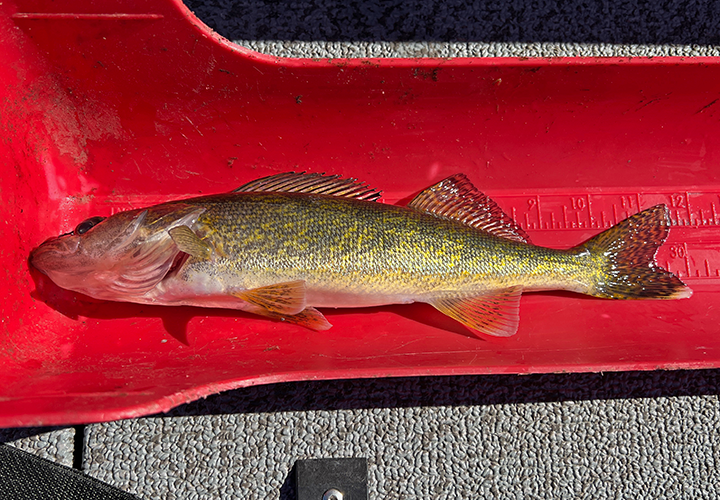 Looking ahead to Winnie’s future, I’ve noticed DNR fisheries nets on Winnie lately, and I’m looking forward to seeing how the population assessments turn out this year. They weren’t too sure at first, but I recall fisheries staff mentioning that the spawning season in 2020 appeared to be promising. The year class was not expected to be anything like the massive, off the charts 2019 year class but hopes among fisheries staff was for a fairly good year.
Looking ahead to Winnie’s future, I’ve noticed DNR fisheries nets on Winnie lately, and I’m looking forward to seeing how the population assessments turn out this year. They weren’t too sure at first, but I recall fisheries staff mentioning that the spawning season in 2020 appeared to be promising. The year class was not expected to be anything like the massive, off the charts 2019 year class but hopes among fisheries staff was for a fairly good year.
Anecdotally, I’ve seen some signs that there might be a decent class of 2020 walleyes. Recently, some of those fish, now 10 to 12 inches long like the one you see pictured here, have been showing up in the mix. On Thursday, not only did we catch a lot of them, but we observed other anglers flipping them into their boats at a steady pace.
Nothing lasts forever, and the super-massive walleye class of 2019 won't either. But we might just be able to stretch if out a little bit and if another strong year class comes along soon, we could enjoy "the best of both worlds" for a few seasons. Good numbers of large fish to catch photo and release, combined with strong numbers of fish to satisfy those of us who love a good fish fry. Wouldn't that be cool? ![]() — Jeff Sundin 218-245-9858 or EMAIL
— Jeff Sundin 218-245-9858 or EMAIL
More Recent Fishing Reports
Sundin 9-30 • Winnie 9-29 • Ely Area 9-28 • LOW 9-28 • Sundin 9-27 • Crappie Report 9-25 • Lake Winnie Report 9-24 • Crappie Report 9-23 • Sundin Walleye Report 9-22 • Ely Area 9-21 • Sundin 9-19 • Follow on Facebook
 Ely Area, Arrowhead Outdoors Fishing Report September 28, 2022
Ely Area, Arrowhead Outdoors Fishing Report September 28, 2022
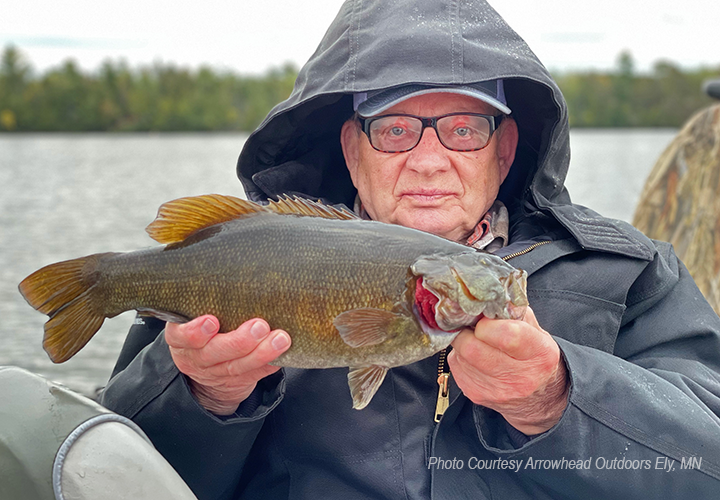 "Walleye reports have become hard to come by as another stretch of poor weather moved into the area. Still some brave anglers, braved the weather and caught some quality walleyes. Angler reports on locations remain somewhat mixed with some reports of walleyes on shallow rocks, in 5 ft of water. Most reports are still on humos ranging from 20-40 feet of water. With water temps now getting down in the high 50’s to low 60’s, big minnows have become the best way to go to catch walleyes. Pike suckers on a jig and creek chubs on lindy rigs have been very effective. Orange/chartreuse, white and gold have been the top colors.
"Walleye reports have become hard to come by as another stretch of poor weather moved into the area. Still some brave anglers, braved the weather and caught some quality walleyes. Angler reports on locations remain somewhat mixed with some reports of walleyes on shallow rocks, in 5 ft of water. Most reports are still on humos ranging from 20-40 feet of water. With water temps now getting down in the high 50’s to low 60’s, big minnows have become the best way to go to catch walleyes. Pike suckers on a jig and creek chubs on lindy rigs have been very effective. Orange/chartreuse, white and gold have been the top colors.
Smallmouth Bass continue to transition to sunken islands, close to deep water and feed heavily. Out here, big active minnows like creek chubs or lite suckers are very hard to beat! Humps that top out from 10-20 feet have been best. Some smallies continue to be found in shallow rocky bays, current areas and around islands. Spinnerbaits and soft plastics have been very effective here.
With cooler water temps, northern pike have become very active this last week. Good numbers of pike are being caught with large suckers fished under bobbers, right off docks, shallow bays, river mouths and weedbeds. Anglers also reported catching pike on spoons and spinnerbaits around weedbeds.
Stream Trout, also thanks to cooler water temps, have started to move shallower and back to within reach of shore anglers. Night crawlers floated off the bottom, small spoons and spinners have been very popular as of late. Anglers fishing from a boat have been reporting that trolling small crankbaits, behind the boat about 100-150 ft, has been very effective for them." — Arrowhead Outdoors, 218-365-5358
 Lake of the Woods, LOW Tourism September 29, 2022
Lake of the Woods, LOW Tourism September 29, 2022
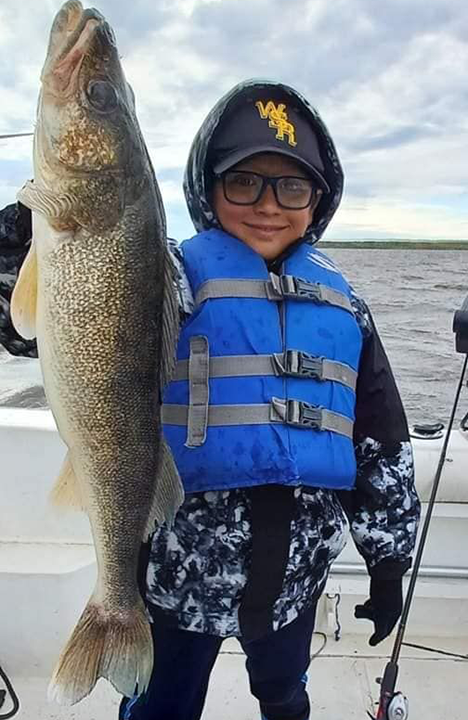 "Walleyes are starting to stack up in various shoreline areas along the south side of Lake of the Woods. Anglers mow report that there is some good fall fishing taking place.
"Walleyes are starting to stack up in various shoreline areas along the south side of Lake of the Woods. Anglers mow report that there is some good fall fishing taking place.
Various techniques are still proving effective in catching, but as water temps cool, jigging will be the desire of walleyes and has been successful this past week. Most of the successful anglers have anchored up and are jigging with fatheads or frozen shiners.
Other presentations will still work, folks trolling crankbaits for exasmple are still catching fish. If you are struggling catching the fish you are jigging or the fish are spread out, try pulling cranks which will put your lure in front of many fish in which you only need a taker here and there for a successful day. Good numbers of fish are still being caught pulling spinners too, especially over the flats or on the outside edges of structure.
There have been some very good reports coming in from those fishing on the Rainy River this week as well. Shiners are in the river and so are the walleyes. Is this the big run? We're not sure, but most anglers are catching fish, and there are some big ones in the mix. This is the beginning stage of the fall walleye run though, and it should only get better as the weeks roll by. Fall is a great time to take your own boat on the small waters of the Rainy River. There are a variety of boat ramps scattered from Wheeler's Point to Baudette east to Birchdale.
These river fish are moving, once you find them, it can be a memorable day. Looking for fish, trying different spots can be helpful in finding fish. Anchoring up in the same spot all day hoping the fish come through can make for a tough day. Anglers report nice fish both in Four Mile Bay and the river, but these fish are moving around. Try different spots until you find them. Look for clouds of emerald shiners, they show up nicely on most sonar.
Jigging with a frozen shiner or trolling cranks in the river are the primary presentations and both are catching walleyes.
Sturgeon activity continues to pick up as water cools. Most fishing the holes of the river. A 3 to 4 ounce weight, with lower current has been sufficient combined with a sturgeon rig loaded with crawlers or crawlers and frozen shiners.
Up at the Northwest Angle, walleye fishing has stayed consistently very good. Walleyes are being caught using the three techniques mentioned above. Some fishing MN waters, others venturing amongst the Ontario side of the lake. Good fish being caught on both sides.
In addition to fish still over deep mud, traditional structure is also holding walleyes. Points, rock islands, sunken islands, neck down areas, etc. Some nice muskies were caught this week. October is traditionally a great month with trolling shorelines in the mix of techniques.
The government of Canada has officially announced they are lifting the COVID vaccination requirement and is allowing the ArriveCan app to be optional starting October 1, 2022. This will make the drive to the NW Angle for many, which includes about 40 miles through Canada, once again possible." — Lake of the Woods Tourism, (800) 382-FISH
 Jeff Sundin "Chilling the Chill-Able" September 27, 2022
Jeff Sundin "Chilling the Chill-Able" September 27, 2022
Fishing action on many of the Itasca Region’s most popular lakes has taken its first hard hit of the fall 2022 season. As the first real cold blast of the season arrived overnight Sunday and into Monday morning, surface water temperatures on many lakes dipped below 60 degrees, most landing into the 58-to-59-degree range. Chilled by the sudden drop in temperature, fish scattered, forcing anglers to “hunt and peck” their way through the day on Monday.
The dive into colder water happens every year, we can’t avoid that, and realistically, it’s a good thing. In fact, it’s really only a bad thing when it happens on the day of your own fishing trip. Dale Anderson, my friend, and fellow guide summed it up well when he said, “We’re still catching fish on and off, but it’s not like I expected, or hoped for.” My own experience was similar, we caught fish here and there, some of them nice ones, but the strikes were random.
In recent reports, I’ve speculated that this first blast of cold weather is what we’ve been waiting for. Typically, this accelerates the die-off of shallow water vegetation and forces baitfish and young of the year gamefish out to the edges and sometimes, even forces them to suspend over open water. We saw lots of suspended “stuff” in the water yesterday. In fact, over open water, the screen of my graph showed an almost solid, carpet like layer of particulates, bait fish, small game fish and the occasional larger game fish.
Some of the gamefish I saw in that homogenized mass were crappies, I know that because I saw folks catching some of them. This could easily mean that once the lakes settle down, the start of a seriously good period of fall crappie fishing will start up. If your favorite fall crappie spots don’t begin producing soon, then I’ll submit that it should be blamed on a lack of fish, rather than un-suitable conditions. Refer to the articles I wrote a few falls back, when crappies never did show up in familiar places, prompting me to go searching for new lakes and new spots.
Walleye, perch, and pike action should pick up again soon too, but I do have some concerns about water clarity. Last week, algae blooms began dying off and lake water turned clearer. On the west side of Winnibigoshish for example, we could easily see the bottom of the lake in 8 feet of water. Sometimes calm, sunny weather helps re-kindle algae and mitigates the effects. But who knows what Mother Nature has planned for the next few weeks.
Days like today, if the forecast is accurate, could be a grind on clear water lakes, which by the way, is almost all of them nowadays. Calm and cold, sunshine, and clear water, sounds like a good time to review this question, received by email on September 23, 2022.
 September 27, 2022 — "Catch More Winnie Walleyes During Calm Weather?"
September 27, 2022 — "Catch More Winnie Walleyes During Calm Weather?"
Q) Mike Vee wrote.; "Just read your September 22, 2022, report. A few other guys and I were just on Big Winnie September 19, 2022, and when the wind was blowing and had cloud cover, had good luck. When the sun came out and the lake flattened out, the action slowed down.
Care to share any tricks in getting more bites in calm water? I would think move deeper, or slow down or speed up. I understand it could be a military secret you would like to keep to yourself, (but) would appreciate any tricks you could provide.
A) Mike, except for in some people’s minds, there are no military secrets in fishing. Helping my fellow anglers is a way of life for me and as you know, a practice that I encourage others to endorse as well. That said, by answering your question at all, I risk giving you the impression that I think I know what I'm talking about, which sometimes I don't. Even after almost 40 years as a full-time guide, I still learn new tricks every day of the fishing season. Luckily though, I have picked up a few, and some could be helpful in situations like you've described.
Walleyes moving deeper during calm weather is always a possibility and we usually do check out a few deep waters spots every chance we get. But in recent years, it becomes more and more evident that many of the fish scatter and spread out across Lake Winnie’s massive flats. In water depths ranging between 12 and 16 feet, there are dozens of miles of this sort of structure. These are all fish that can be caught, but the trick is pinning down the small schools of fish and presenting bait to them.
This summer, folks targeted fish on the flats successfully, some using spinners, some using jig and minnow combos and others trolling crankbaits.
Some of the better suggestions about effectively fishing the flats have already been covered in recent articles. So, I'd encourage you to read several of them. There’s one that stands out, written just last week, the report from September 23, 2022, has several "tips" contained within it, some from me and some are links to great information provided by others. Read >> Fishing Report September 23, 2022
Weather forecasters predict the dive into cold weather to moderate soon, and that should spark a recovery. Today’s weather forecast though appears to be offering me a chance to gather even more, firsthand information that pertains directly to your question. So, while I grind away on the lake, pondering your specific question, I hope you’re review that report. Over the next few days, I’ll add more tips and tricks that we use, in real time.
As usual, I’m up against the clock, and have to hit the road. Please check back tomorrow for additional updates and if you’re on the lake today, good luck! ![]() — Office Cell Call or Text 218-245-9858 or EMAIL
— Office Cell Call or Text 218-245-9858 or EMAIL
 September 26, 2022 — "Seriousy, The Rainbow Fish Meditation?"
September 26, 2022 — "Seriousy, The Rainbow Fish Meditation?"
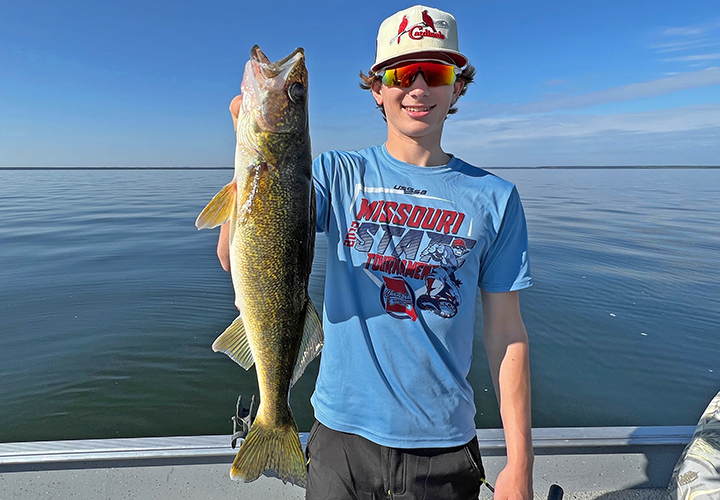 On Friday (9-23-2022) Garet Sjleeoff wrote; “Hey Jeff, I was listening to you on the radio (KAXE Morning Show) yesterday morning and heard you talking about some kid who caught fish by talking to them. Were you just making a silly joke, or were you really serious about that?
On Friday (9-23-2022) Garet Sjleeoff wrote; “Hey Jeff, I was listening to you on the radio (KAXE Morning Show) yesterday morning and heard you talking about some kid who caught fish by talking to them. Were you just making a silly joke, or were you really serious about that?
Garet, the story you’re referring to was real, albeit both anecdotal and subjective. It may have been my first reference to the “Rainbow Fish Mediation” on the radio, but fishing customers have heard about it many times in my boat, particularly whenever the fish aren’t fully cooperating with us.
The instance I mentioned that morning was part of a recap of a recent fishing trip with the Hank and Terri Milius family, longtime customers, and friends. Before we ever dropped our lines in the water that day, Ethan Milius, their grandson, started off the conversation by saying; “I’m tired of everybody else catching all the big fish on every trip. I want to catch a big one this time, at least 1 fish in the slot so I can get my picture taken and let it go today.” I explained that all he needed to do was use the Rainbow Fish Meditation.
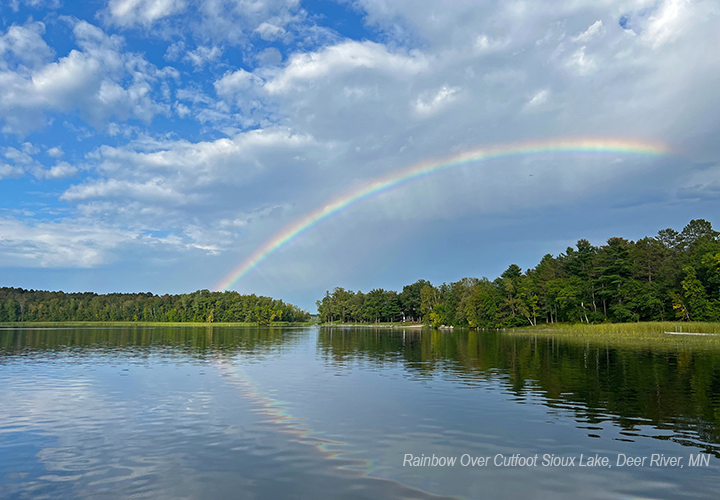 Don’t expect me to take credit for knowing about the Rainbow Fish Meditation, “The Hippie Chick” taught me about it 6 or 7 years ago. She explained it as an inherent ability that we all have, one that allows us to tap into our instincts at a higher level. So, if you think about it, it’s a process of communicating directly with the fish instead of relying on skill, intelligence, or even dumb luck.
Don’t expect me to take credit for knowing about the Rainbow Fish Meditation, “The Hippie Chick” taught me about it 6 or 7 years ago. She explained it as an inherent ability that we all have, one that allows us to tap into our instincts at a higher level. So, if you think about it, it’s a process of communicating directly with the fish instead of relying on skill, intelligence, or even dumb luck.
Back to Ethan’s story, after listening to my best effort at explaining it, he picked up on the theme and started using the super information highway to tell the fish what he needed. Once they knew the outcome he had in mind, they provided the results he wanted. First, he caught and released a 20-1/2-inch walleye, a protected slot-fish on Lake Winnie. Not long after that, he caught another one, a 22-1/2 fish, also in the protected slot. Ethan was on track to overtake his sisters record of 24 inches, but time was working against him. Our scheduled trade off at the dock ended his time to practice the RFM any longer.
The subject apparently resonated with other listeners too. Shortly after the segment, Heidi Holtan, morning show host and the station’s program director text me. “Magical today! Got this text from a mom of 8-year-old son Rory.” The mom, Hattie sent over a photo (left) of Rory holding a nice Largemouth Bass. Paraphrasing Hattie’s message; “I am messaging for my son Rory who loves to fish and listening to the radio show in the morning before getting up. He’s had a great summer, lots of luck with panfish, pike, bass, and perch on our lake.”
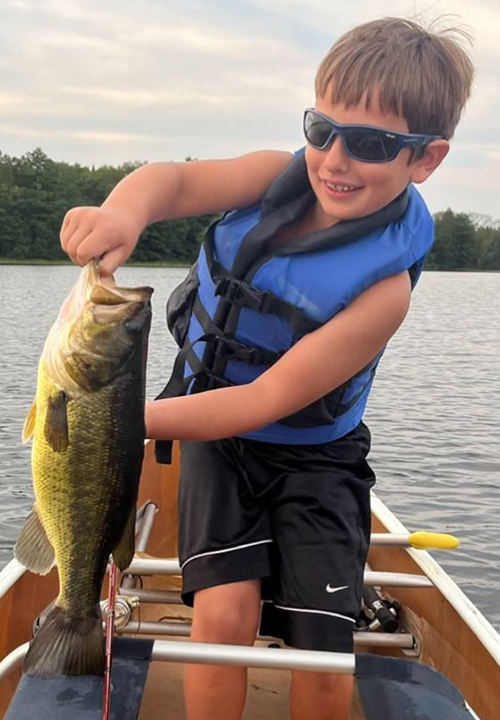 Thank you, Hattie, for offering the image of Rory and permission to mention the story publicly. Apparently, Rory has already tapped into the power of his own instincts about fishing, and it’s worked. I suppose in a few more years he’ll be taking it up to a whole new level, combining technology with his instincts to become a big-time-pro, power-house angler. Who knows, maybe he’ll even be the Thursday morning guest on KAXE? The Early Bird 2, with Rory … has a nice ring to it.
Thank you, Hattie, for offering the image of Rory and permission to mention the story publicly. Apparently, Rory has already tapped into the power of his own instincts about fishing, and it’s worked. I suppose in a few more years he’ll be taking it up to a whole new level, combining technology with his instincts to become a big-time-pro, power-house angler. Who knows, maybe he’ll even be the Thursday morning guest on KAXE? The Early Bird 2, with Rory … has a nice ring to it.
Whenever I mention the RFM to my fishing customers their first question is usually what is that? “It’s whatever you think it is, it’s your ability to allow your own instinct and natural powers to take over.” That’s what I tell them. When you think about it, humans, the mammal have been around for a long time. About 200,000 years in the form, we recognize today, according to this article “Evolution of The Modern Human” found on the website your genome dot com.
So, a few thousand years ago, we started getting “smart”. But only recently have we become smart enough to start believing that we are actually in control of anything. It’s just and idea, but if you want to be a better angler, try avoiding some of that intelligence and start tapping into instincts that go all of the way back to our primordial ooze.
You can “poo-poo” the idea if you want, folks with high intellects often do. But I don’t, I’ve seen people tap into their instincts with open minds and happy hearts and when they do, the results are usually rewarding. Sometimes, when the going gets tough, I even call in the Hippie Chick for added support. Like she says, “whenever 2 or more are gathered, good things start happening!”
Today, back on the lake with Kyle and Karen. With crappies and walleyes already in the freezer, pike, perch, or sunfish will top the list. Updates about that, along with answers to more reader questions tomorrow morning. ![]() — Office Cell Call or Text 218-245-9858 or EMAIL
— Office Cell Call or Text 218-245-9858 or EMAIL
 Jeff Sundin "Another Step Closer - Fall Crappie Patterns" September 25, 2022
Jeff Sundin "Another Step Closer - Fall Crappie Patterns" September 25, 2022
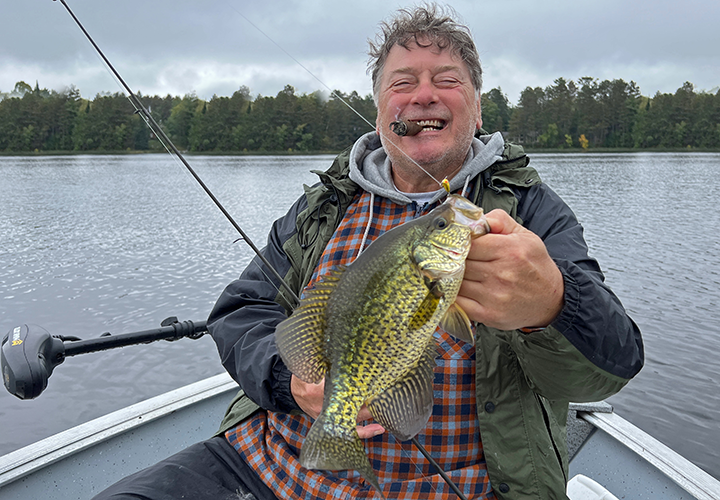 A few days back, I promised to share my observations regarding fall crappie migrations toward early fall habitat. Happily, I can report today that on Saturday, 9-24-2022 Kyle, Karen and I noticed significant steps forward in both crappie movement and activity levels. To say that we were on a “hot bite” would be stretching it, however “slow-but-steady”, heavy emphasis on steady, sums it up nicely.
A few days back, I promised to share my observations regarding fall crappie migrations toward early fall habitat. Happily, I can report today that on Saturday, 9-24-2022 Kyle, Karen and I noticed significant steps forward in both crappie movement and activity levels. To say that we were on a “hot bite” would be stretching it, however “slow-but-steady”, heavy emphasis on steady, sums it up nicely.
The lake we fished isn’t one that I fish a lot, but I’ve been there enough times over the years to call it “familiar territory. Still, I have not fished there a single time this year, so in that regard, it was “fresh territory” and I’d have to do some searching before fishing.
The water temperature, at 62.5 degrees was a little warmer than Winnie and some of the other waters we’ve fished recently. I was concerned about that when we first started, mostly because my first couple of spots bombed out. I didn’t want to spend the whole day grubbing around in the weeds in search of crappies, so I opted to try looking at one more spot. The bay, with a maximum depth of 35 feet, has a couple of holes that lay adjacent to a large, weedy flat.
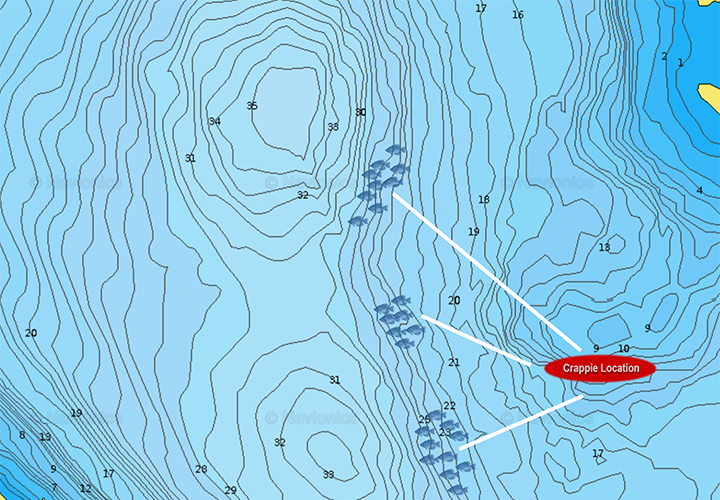 The map reveals what we found on our search of the breakline between the flat and the deeper holes. Crappies were moving toward the holes, but still holding tight to the breakline. Some fish we deeper than others, understand that it could change daily, but 23 feet was the magic number for us on Saturday.
The map reveals what we found on our search of the breakline between the flat and the deeper holes. Crappies were moving toward the holes, but still holding tight to the breakline. Some fish we deeper than others, understand that it could change daily, but 23 feet was the magic number for us on Saturday.
You can see the Lindy Live Bait jig in the photo above of Kyle holding one of his better catches. We started with a variety of colors, but before long, that 1/8-ounce size, gold color was tied on to all three of our lines; the fish really liked that one yesterday. We tipped them mostly with the smallest fatheads in my tank, but I did try using cut pieces of night crawler too. Sunfish might be in the mix I thought, so the worms represented a test. I caught 2 small sunfish, but apparently crappies made up the lion’s share of the fish we were marking on the graph.
I mentioned earlier that the action was “slow-but-steady”, here’s what I meant. We found the 1st school of fish at about 9:30 AM. We dropped the Reynold’s 20th crappie in the livewell at 12:30 PM. There were a few smaller fish, releasable thanks to being in shallower water, so I guess our catch rate might have been 8 to 9 fish per hour. If the fish weren’t so nice, it might not have been too exciting, but with sizes ranging between 11 to 13 inches, it was worth the effort.
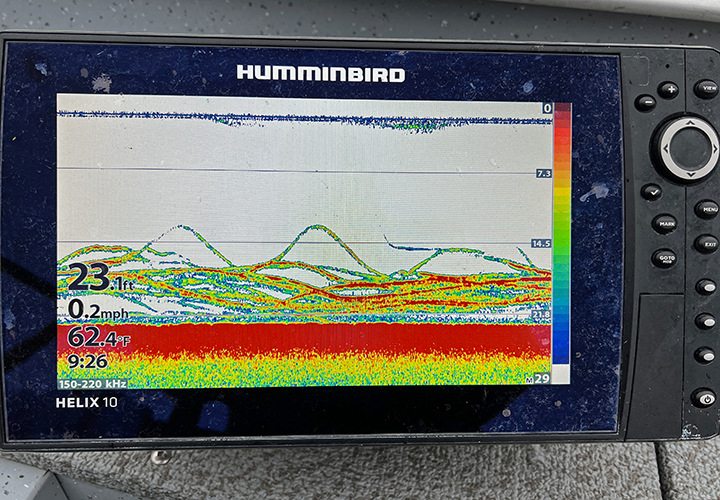 On a different level, it was exciting for me because it was my first return to the dock with 20 crappies so far this fall. Not that we haven’t caught some on previous trips, but this episode marked a noticeable improvement over recent trips.
On a different level, it was exciting for me because it was my first return to the dock with 20 crappies so far this fall. Not that we haven’t caught some on previous trips, but this episode marked a noticeable improvement over recent trips.
Perch, walleyes, rock bass, smallmouths, and pike, heavy emphasis on pike, made up the afternoon action plan. Jigging was a good way to get strikes, but it was a better way to get snipped of by the “scissor bills”. So, we tried our hands at trolling spinners on the weed edges. Pike, pike, pike, and a few perch were what we drummed up with that presentation. From 1:00 PM to 4:30 PM, we had a lot of action, but I didn’t see anything that makes me want to go back any time soon.
I’ll be fishing with the Reynolds again tomorrow, Tuesday too, but we have sandwiched in a scheduled day off today. So, since I’m in dry dock this morning, I’ll take this chance to spend some extra time answering reader questions that have come in recently.![]() — Jeff Sundin 218-245-9858 or EMAIL
— Jeff Sundin 218-245-9858 or EMAIL
 September 25, 2022 — "What's Better, Keeping Bigger Fish or Little Ones?"
September 25, 2022 — "What's Better, Keeping Bigger Fish or Little Ones?"
On September 24, 2022 Travis Verdegan wrote;
Q) "Hey Jeff, Interesting you mentioned your voluntary limit of 16 inches on Lake Winnie. I’d like to say I’m going to stick to that, but sometimes my decisions come down to the order in which I catch fish, the species I catch first, the circumstances of the trip and even how badly the fish was hooked. I like to ensure a meal, which can be two or three decent fish for my family, then when the pressures off it becomes easier to be more selective. Hypothetical question. If you had to choose between the two, would you keep 1 23-1/2 inch walleye over harvesting multiple, (2 to 3), 14 inch walleyes?
For me over-size fish, 23 inches or larger, usually get lumped right in with the (protected) slot fish, 18 to 23 inches. I’m reconsidering given the population dynamics setting up on Winnie. Thanks, Travis"
A) The September 23, 2022, article you mentioned contains information about the sizes of fish that would be "My Preference" to harvest. I, like you, love bringing home fish to eat and certainly do have a responsibility to my customers regarding harvesting some fish as well. Admittedly, my voluntary, self-imposed practice of aiming at fish from the 2018-year class on Winnie is both subjective and nuanced.
Personally, my short answer to your question is that I’d probably harvest the 23-1/2 fish before I would take a couple of 14-inch ones. According to training by folks who work for the DNR, the 23-1/2-inch fish has already lived to complete several spawning cycles. There’s a good chance that some of the 2018-year class fish, particularly the males, spawned this past spring. But smaller fish from the 2019-year class probably did not. So, if you believe that giving the 2019s a chance to reproduce at least once is a good idea, then releasing them now makes sense.
Another consideration, and it’s a big one, is what will happen when fish from the 2018-year class reach the protected slot limit size of 18 inches? I’ve been counting, and this month, 9 of those 2018-year class fish that were caught in my boat already have. Within the past few weeks, we’ve released 7 walleyes that were slightly over 18 inches and 2 more fish that were too close to call, 17.98 inches or so. This brings us back to my original point which was to point out a strategy that might help extend the current “bull market” on Winnie Walleyes.
Quoting me from the original article; “If you recall the years when folks groused about catching lots of fish on Winnie but had to release them all because they were in the protected slot, then you may already agree with my viewpoint that those days will be coming again, sooner than we think. So, if we were to set our sights on harvesting more fish from 2018 and less of them from the 2019 class, we could extend the great fishing for another season, maybe two.”
The problem with my preferences is that seldom do the fishing conditions turn out to be that simple. There are days when we can practice the voluntary harvest size limit and days when we can’t.
As you correctly point out, there are times when the “philosophy” and the “practice” do not align. If I’m having a tough day on the lake and my customers are looking at me, wondering how I will get them some fish, you can bet your homestead that I will harvest some of the 2019-year class, 14-to-15-inch walleyes. That said, there are also days when the bite is hot and heavy, times when being selective is easy and when we can, we do.
My philosophy makes sense to me, and I would love it if more people shared my views. But I understand that most folks will not. Unlike others who seek to “conserve” fish by imposing their regulations on you, I choose to attempt education. Whenever I put my best, most logical argument forward, there are always a few believers. They influence their friends and eventually, positive practice sharing begins to pay off.
From what I’ve learned talking to DNR biologists, harvesting some of the 2019, 14-to-15-inch fish does not overly concern them. In terms of the lake’s walleye biomass, harvesting 1 23-1/2-inch walleye doesn’t make them lose sleep at night either. So, if you’re on the lake and she’s not offering options, harvest either of them. But, if you’re having a banner day, at least consider doing what you can to push some of the 2019 fish into the next season and keep a few of the 2018s out of “protective custody”.![]() — Office Cell Call or Text 218-245-9858 or EMAIL
— Office Cell Call or Text 218-245-9858 or EMAIL
You Are Invited To Become A Duly Deputized Fishrapper Cub Reporter
 If you've been waiting for a gold engraved invitation to participate in the daily reports, then stop waiting and consider this your own personal invitation.
If you've been waiting for a gold engraved invitation to participate in the daily reports, then stop waiting and consider this your own personal invitation.
Helping your fellow fishermen and women stay abreast of fishing conditions in your area is good for everybody and it's easier than you think! You don't have to write a book, you don't have to share your secret fishing spots and you don't even have to mention your lake. But even a few words about general trends, seasonal patterns and local weather conditions can really help.
Be like me, become a duly deputized "Cub Reporter", it's good for fishing! Contact Us or if you prefer to be "social", Fishing Reports Minnesota, the Facebook counterpart to this page is open to the public, so you can post your own fishing update or just share a photo of a nice catch.
 Jeff Sundin "Fall Crappie Migration - One Step Closer" September 23, 2022
Jeff Sundin "Fall Crappie Migration - One Step Closer" September 23, 2022
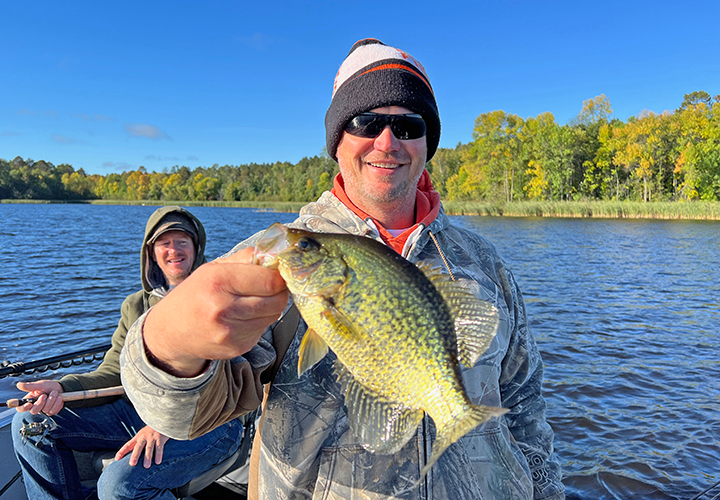 Apparently, the cold snap that arrived last Wednesday has triggered some movement of crappies into early fall habitats. Surface water temperatures, 64 degrees as of Thursday morning, may bounce back during calm and sunny days, but do not retain the warmth overnight. They are currently trending downward and will continue that trajectory, I think.
Apparently, the cold snap that arrived last Wednesday has triggered some movement of crappies into early fall habitats. Surface water temperatures, 64 degrees as of Thursday morning, may bounce back during calm and sunny days, but do not retain the warmth overnight. They are currently trending downward and will continue that trajectory, I think.
With cooler water temperatures, some of the shallow weed varieties have begun to decay too. As the shallowest water become less inhabitable, pods of baitfish have moved out and are showing up out in open water. With the food chain moving out, it’s just a matter of time before crappies, and other gamefish move out to capitalize on the bounty.
As of a day or two ago, reports began emerging about folks who were catching crappies that had moved toward deeper, open water, early fall territory. Paraphrasing Bryan Harris, Eagle Nest Lodge on Cutfoot Sioux, “Crappies have finally cooperated for some of our guests, we’ve had a couple groups bringing some in these past few days.” Another friend reported that his father had started getting some panfish in one of the popular, early fall destinations too, on the same day.
After hearing those reports, I forced myself to try the open water pattern again on Thursday. I used the term “forced myself” because after struggling to find crappies in any of my favorite early fall locations, I was reluctant to burn up too much time searching for them when I could be keeping my crew busy catching something else. But they were interested in catching some specs, and I was eager to please them. So, with the aviso that we weren’t going to make a career out of finding them, we set about the search.
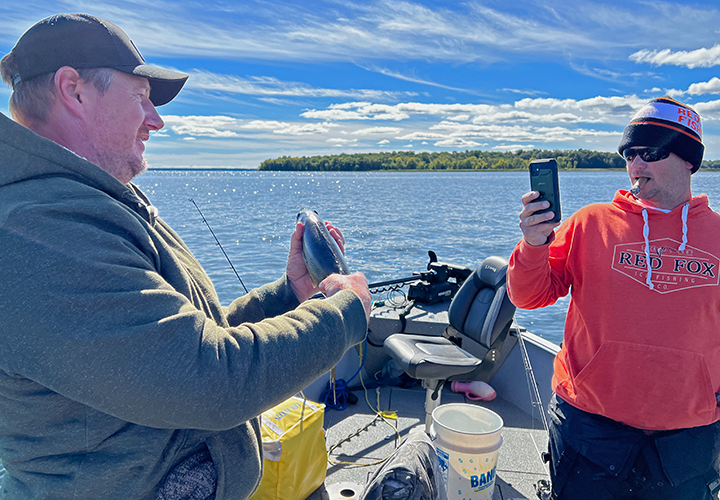 As you can see, we did catch some and the average size of those we harvested was good. But we did not catch limits of them, and they were not stacked up in large schools either. Scattered, small packs of fish numbering in the 1 to 10 fish range were spread out across the lake. As a combo search/triggering presentation, trolling spinners was the best approach for us. If our intent was to spend the whole day fishing for crappies, hovering over the small packs of fish using jigs, slip-floats, or other vertical presentations.
As you can see, we did catch some and the average size of those we harvested was good. But we did not catch limits of them, and they were not stacked up in large schools either. Scattered, small packs of fish numbering in the 1 to 10 fish range were spread out across the lake. As a combo search/triggering presentation, trolling spinners was the best approach for us. If our intent was to spend the whole day fishing for crappies, hovering over the small packs of fish using jigs, slip-floats, or other vertical presentations.
Time is a cruel master though and ours was set to run out at 11:00 AM, a deadline aimed at allowing time to travel, locate and catch walleyes. So, as it was, trolling spinners was the only presentation we used and that allowed us to harvest 14 of a would-be 30 fish limit. There were other, smaller fish caught and released along the way too, so all-in-all, we considered our experiment a success.
I think the open water experience was a good start and a step in the right direction. But not all the fish had moved out into open territory yet. Before our episode of trolling spinners, we caught some fish casting small jigs and plastics into the weeds. As I reported on Wednesday (9-22-22), and as I reported on September 21, 2022, the only crappies we’ve previously located were also on weed edges, or along shallow breaklines adjacent to them. So, I’ll bet that if you wanted too, you could still locate crappies in shallow weed cover today.
With the crappie fishing experiment behind us, walleyes moved up to agenda item #1. First, the conversion to walleye fishing required a half hour ride to Lake Winnie, so it was probably close to noon before we dropped our lines back in the water.
Deciding where to drop them was a head scratcher for me. That's because Wednesday’s strong northwest winds had been replaced by smooth, glassy calm water. Surface temperatures had dropped from the high 60s down into the lower, 63-to-64-degree range and there was a noticeable “improvement”, if you want to call it that, in water clarity. The “mini turnover” forced by Wednesday’s cooler temperatures and white capping water killed off some of our precious algae bloom. Being able to clearly see the bottom content in 7 to 8 feet of water was discouraging to me, so I decided to make our first stop in deeper water.
The largest mid-lake bars and some of the larger mid-lake humps have been holding walleyes for a while now. So, I returned to the middle, where we’d done well on Tuesday, the most recent calm day. We rigged up ¼ ounce Lindy Live Bait Jigs, tipped them with the largest fatheads I had and dropped them into 16 feet of water, on top of, but along the outside edge of the bar. Almost instantly, Andy hooked a walleye, reeled it close to the surface where it came unpinned and swam away. In another minute, I hooked one and reeled it close to the surface where mine also came unpinned and swam away. Hmm... this isn’t starting off so good, I thought.
The action on the bar stopped after that, so our next move was based on a suggestion from a fellow guide. They were catching some fish “on the flats” using jigs and minnows. The territory was familiar because they were same ones where we’d been trolling spinners a month ago, so that’s where we went next, a patch of gravel located in about 13 feet of water, high atop the sprawling flat.
There have been a variety of good reports about "fishing the flats on Winnie" this summer. So, instead of re-writing all of the information, use the links below to the following reports from Lake Winnie during the mid-August 2022 period.
- Bowen Lodge Lake Winnie Report August 4, 2022
- Pines Resort Lake Winnie Report August 29, 2022
- Sundin's Lake Winnie Report August 22, 2022
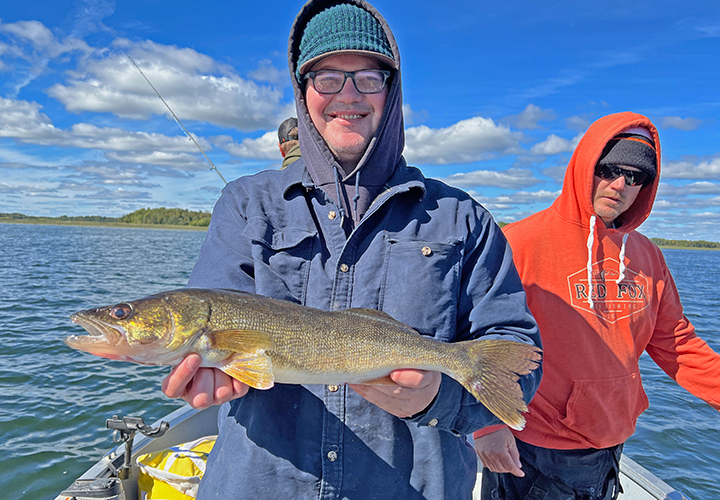 The first stop or two produced a little action, but we weren’t setting the world on fire. By 2:00 we’d caught maybe 3 or 4 keepers and a couple of slot-fish. I’d located a “new” to me spot that looked promising and were grinding away when another fellow guide called, reported having some action along the shoreline and invited us over. So, we pulled up and headed over to try our hands at weed edge fishing.
The first stop or two produced a little action, but we weren’t setting the world on fire. By 2:00 we’d caught maybe 3 or 4 keepers and a couple of slot-fish. I’d located a “new” to me spot that looked promising and were grinding away when another fellow guide called, reported having some action along the shoreline and invited us over. So, we pulled up and headed over to try our hands at weed edge fishing.
Now using 1/8-ounce jigs that we’d rigged up during the ride over, we caught a keeper, then another “slot-fish” within a few minutes of stopping. Things were looking up, especially in light of the conversation I had with a former fishing customer, he and his fishing buddy were filled out, heading back to their cabin for a fish fry. Up the shoreline, my guide buddy was filled out too and he was taking his crew back to shore already too. By now I can feel the makings of an easy day coming along, but not this time.
I guess we got there too late, or I didn’t figure out the right pattern, or whatever. A half mile stretch of shoreline produced numerous small northern pike, but no more walleyes. We motored further up the shore, tried the same approach, and picked up another keeper, but it was clear that we missed the boat, pun intended, on whatever hot bite the boys were enjoying before got there. The results were discouraging enough but looking through the clear water and seeing the bottom of the lake again added fuel to the fire; we needed to get out of there and find our own fish.
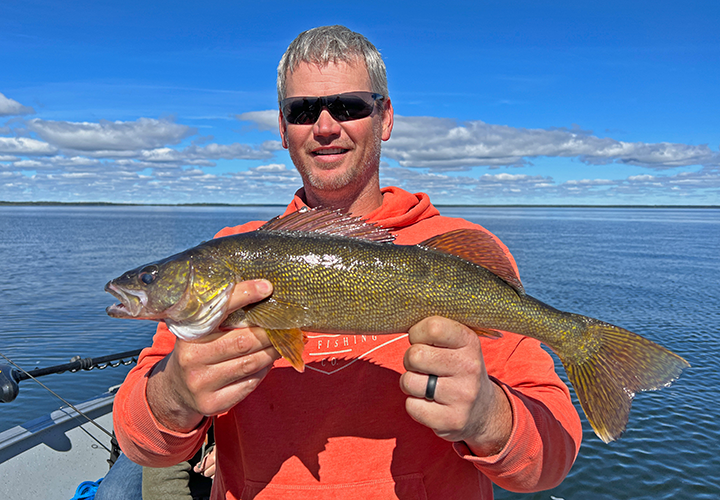 By now, it’s past 4:00 PM and we have 5, maybe 6 keepers in the livewell. I’m reserved to the idea that crappies might have been the highlight of our day but wasn’t ready to give up yet. So, back out to the flats we went, stopping on another gravel patch, this one located in 12 feet of water. Slow trolling at .4 to .5 MPH and barely twitching the tips of our fishing rods produced another walleye and a couple of jumbo perch. We were on the right track, but the action was still lacking so I decided to make one more stop and headed back out to “Andy’s Rocks”, the new spot we’d found before getting the phone invitation earlier.
By now, it’s past 4:00 PM and we have 5, maybe 6 keepers in the livewell. I’m reserved to the idea that crappies might have been the highlight of our day but wasn’t ready to give up yet. So, back out to the flats we went, stopping on another gravel patch, this one located in 12 feet of water. Slow trolling at .4 to .5 MPH and barely twitching the tips of our fishing rods produced another walleye and a couple of jumbo perch. We were on the right track, but the action was still lacking so I decided to make one more stop and headed back out to “Andy’s Rocks”, the new spot we’d found before getting the phone invitation earlier.
I don’t remember the exact order of who caught what or when, but suffice to say that between 4:45 and 5:30 PM, I went from being zero to hero. There was a school of fish on that bar, they were willing to strike, and we ran up our total to 18 walleyes in short order. I guess sometimes you just gotta keep fishing, you’re never out of the game until the boat is on the trailer.
Was it experience, skill, dumb luck, or adaptability? OR was it the Rainbow Fish Meditation, who knows for sure? All I can say is that this is not the first time you’ve read a story like this one. Whatever happened to put us on that spot, at that time was not coincidence, it happens routinely.
Today, I start on a 4-day mission to find a little bit of everything and I’m looking forward to it. Kyle and Karen Reynolds are customers, but friends too and they don’t mind letting me find new and interesting things to do. Don’t get me wrong, they like to take home fish, but with 4 days to gather them, there’s a little more leeway to experiment. So, we’ll take it day-by-day and choose the right lakes for the right weather and hope for a great outcome. More about that as events unfold.
One last thing before I head out the door this morning. I noticed that fishing traffic on both Cutfoot Sioux and Lake Winnie was robust yesterday. It’s likely to get even busier out there today and tomorrow, so there will be a lot of pressure on the fish.
Anecdotally, I’ve already counted a total of 9 walleyes from the 2018-year class that have already achieved “slot-fish” status. These fish have measured 18.01 to 18.25 inches and soon, there will be a lot of them. Many of the super abundant 2019-year class fish now range between 14 to 14.5 inches and folks do consider these fish desirable. But fishing is good on Winnie right now and there are also a lot of fish from the also very strong 2018 that measure 16.5 to 17.5 inches.
If you recall the years when folks groused about catching lots of fish on Winnie, but had to release them all because they were in the protected slot, then you may already agree with my viewpoint that those days will be coming again, sooner than we think. So, if we were to set our sights on harvesting more fish from 2018 and less of them from the 2019 class, we could extend the great fishing for another season, maybe two.
It’s up to you of course, but I have my eyes on a new, “Jeff’s Boat” voluntary minimum size of 16 inches this fall. I realize that we will harvest a lot fewer fish this way, but that’s the point. Get some portion or fish out of the 2018 year class before they all become slot-fish and save a greater portion of the 2019 year class for next year, when the same cycle will repeat again. Either way you choose, good luck out there! ![]() — Jeff Sundin 218-245-9858 or EMAIL
— Jeff Sundin 218-245-9858 or EMAIL
 Jeff Sundin "Reliable Fall Walleye Bite In Progress" September 22, 2022
Jeff Sundin "Reliable Fall Walleye Bite In Progress" September 22, 2022
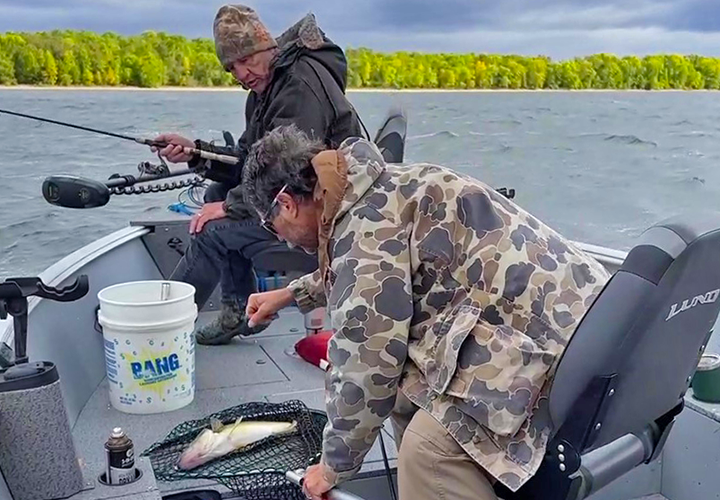 Wednesday’s strong, cool, northwest wind might not have been fun for boating, but for most folks who braved the elements, wetting a line was rewarding.
Wednesday’s strong, cool, northwest wind might not have been fun for boating, but for most folks who braved the elements, wetting a line was rewarding.
The day before, Tuesday, the surface water temperature was 67 degrees at the end of my fishing trip. By Wednesday morning, the reading was 65 degrees at the beginning of our trip and from there it slowly slid downward into the 64.5-to-64.8-degree range. With overnight lows in the 30s that occurred last night, I suspect my graph will register another reduction in surface temperatures when we arrive at the lake later this morning.
Without doubt, the falling water temps are kicking walleyes into fall feeding mode. On Monday and Tuesday, surface water was smooth, and admittedly, the bite was tricky. But for folks who knew how to work the system, even calm water did not kill the walleye bite, they were cooperative. That said, folks who did not know the tricks, struggled getting fish to strike hard enough for easy detection.
 Wednesday was a whole different story though, the rolling waves and whitecaps churned up a feeding frenzy and walleyes struck aggressively. Any reasonably adept jig and minnow angler managed numerous strikes. Throughout the day, friends reporting in with me had all caught limits of fish and some reported catching upwards of 50 fish in certain, select areas. For me, the crew’s limits were already filled before a scheduled noontime drop-off of 1 crew member. There was no reason for us to make a 2nd trip across the rough lake, so that encouraged us to move into calmer water, fishing crappies, perch, or pike.
Wednesday was a whole different story though, the rolling waves and whitecaps churned up a feeding frenzy and walleyes struck aggressively. Any reasonably adept jig and minnow angler managed numerous strikes. Throughout the day, friends reporting in with me had all caught limits of fish and some reported catching upwards of 50 fish in certain, select areas. For me, the crew’s limits were already filled before a scheduled noontime drop-off of 1 crew member. There was no reason for us to make a 2nd trip across the rough lake, so that encouraged us to move into calmer water, fishing crappies, perch, or pike.
I’m not saying that trolling the spinners and minnows won’t catch fish anymore, they definitely will. BUT if you like jigging better, then you can rest assured that the “jig bite” has started. On Monday, we caught fish 50/50 by jigging and spinning. On Tuesday, we caught fish 80/20 by jigging and then spinning. On Wednesday, 100% of our walleyes were caught using ¼ ounce Lindy Live Bait Jigs tipped with the larger fatheads in our pails.
After our trip back to shore, I asked about the crappie bite that resort guests had reported. Word on the street was that cooler water temperatures has started up the “crappie bite”. From we what observed, they did, but not completely and many of the fish we found were sub-standard in terms of size. Crappies in the 6-to-8-inch range struck with authority, but not many fish over 10 inches, “keepers” in my opinion, were landed.
Most folks think of the fall crappie bite as a time when the fish move away from the weedy shorelines and begin stacking up over deeper, open water territory. On Wednesday, the fish we found were either in the weeds, or located on the shallow breaklines adjacent to them. Some folks who were catching crappies reported finding them in small packs that were holding tight to stumps and debris on the bottom. One friend has located many of these small “snags” and marked them on his GPS. Trolling spinners and zigzagging from one stump to another helped him put some fish in the livewell yesterday.
Like I said, we found crappies on the shallow breaklines, trolling spinners was the presentation we used too. If the fish we’d caught would have been larger, it could have turned out to be my first crappie-walleye combo limit of the fall. I’ll get another chance to try that today, in fact almost every day for the next week, so stay tuned.
I wish I had more time to mention specifics about the week in a methodical, day-by-day order. But this is crunch time for me and I can’t squeeze everything into the mornings before my charters begin. I’ll try to drop in more details every day, but if I’ve overlooked something that’s important to you, shoot me a message so I can address the topic specifically. ![]() — Jeff Sundin 218-245-9858 or EMAIL
— Jeff Sundin 218-245-9858 or EMAIL
 Ely Area, Arrowhead Outdoors Fishing Report September 21, 2022
Ely Area, Arrowhead Outdoors Fishing Report September 21, 2022
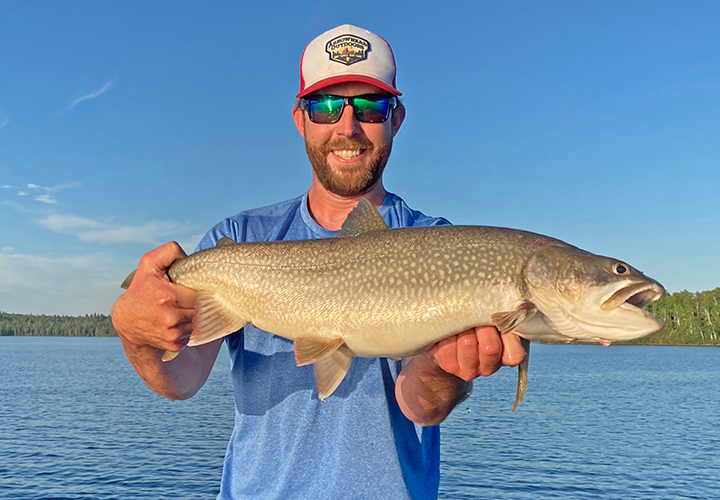 "Lake Trout anglers have been finding lakers in 30 to 60 feet of water, just off sharpe dropoffs as of late. Trolling spoons behind down riggers has been very effective for anglers fishing from a boat. Anglers fishing from a canoe, have been having luck vertical jigging heavy bucktails and heavy tube jigs, in these same areas.
"Lake Trout anglers have been finding lakers in 30 to 60 feet of water, just off sharpe dropoffs as of late. Trolling spoons behind down riggers has been very effective for anglers fishing from a boat. Anglers fishing from a canoe, have been having luck vertical jigging heavy bucktails and heavy tube jigs, in these same areas.
Walleye fishing seems to of improved this last weekend, despite poor weather going into the weekend. Water temps went from the low 70’s to mid 60’s, almost over night. With that the bite went from crawlers to minnows almost over night. While trolling continues to produce walleyes, the majority of anglers have switched back to a jig and minnow combo, to put walleyes in the boat. Walleye have also really started to transition to their favorite fall haunts and more normal depths of 15 to 40 feet of water. Gold, orange and white have become the hot colors this last week.
Smallmouth Bass, like the walleyes, a sudden drop in water temp has triggered the smallies to transition to their fall haunts and really start keying in on big minnows. Lindy rigging with big 5 to 8 inch minnows, around and on top of sunken islands, in 10 to 25 feet of water, is where to look and catch the biggest smallies in a lake. Some smallies can still be located on shoreline and around islands in 10 feet of water or less, with spinnerbaits and soft plastics, but look for that bite to continue to fade as we go into fall and late fall." — Arrowhead Outdoors, 218-365-5358
 Lake of the Woods, LOW Tourism September 21, 2022
Lake of the Woods, LOW Tourism September 21, 2022
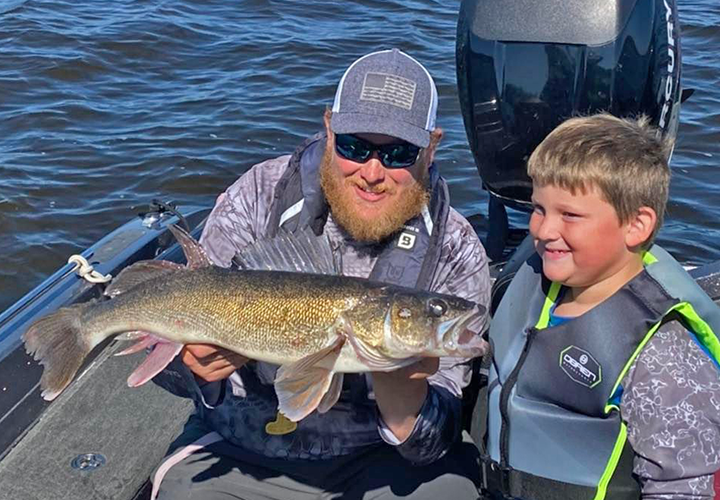 "Walleye fishing has been great all year up at the Northwest Angle, and the trend continues. Walleyes are being caught using the three techniques mentioned above. Some fishing MN waters, others venturing amongst the Ontario side of the lake. Good fish being caught on both sides.
"Walleye fishing has been great all year up at the Northwest Angle, and the trend continues. Walleyes are being caught using the three techniques mentioned above. Some fishing MN waters, others venturing amongst the Ontario side of the lake. Good fish being caught on both sides.
North and Northeast of Little Oak over the deep mud of Little Traverse Bay continues to hold good numbers of walleyes. Scattered schools of fish over the deep mud of Little Traverse Bay. Typical structure holding walleyes. Points, rock islands, sunken islands, neck down areas, etc. With over 14,000 islands, lots of spots and lots of fish. Muskie anglers reported an active week of fishing. With colder water, it should get even better. " — Lake of the Woods Tourism, (800) 382-FISH
There were still lots of walleyes being caught on the south side of Lake of the Woods during the past week too. September is a transition month with the shorter days, colder water temps and walleyes often transitioning. Once you are on them, they are normally very cooperative.
Once again this week, walleyes are being caught using a few different techniques. Drifting or trolling spinners, jigging and trolling crankbaits. As the season progresses, a jig and minnow will be the goto presentation. That hasn't happened quite yet, but there are a lot of walleyes caught jigging.
Good numbers of fish are still being caught pulling spinners. Normally, 1.0 to 1.25 mph, pulling your presentation through numbers of fish. This technique covers water and can be used around structure.
Trolling crankbaits can be effective literally all year long in the open water. The key, getting your baits down to the fish using lead core line, downriggers, snap weights, a 4 ounce bottom bouncer with a 6 foot long mono or fluorocarbon leader, etc. Lots of ways. Then dial in speed, color, size of crank, etc. It's a fun formula to figure out and is catching a lot of fish.
Fall is a great time to take your own boat on the small water of the Rainy River and cash in on good fall fishing! There are more and more walleyes are showing up in the Rainy River this week. Water levels have dropped as has the current. Anglers reporting nice fish both in Four Mile Bay and the river, but these fish are moving around and not necessarily consistent. They may be in the bay one day and swim up river the next. Jigging with a frozen shiner or trolling cranks in the river catching walleyes.
Sturgeon activity is picking up as water cools. Various sized fish being caught with some mixed in beasts near 70 inches. Most fishing the holes of the river. A 3 to 4 ounce weight with lower current has been sufficient combined with a sturgeon rig loaded with crawlers.
 Lake of the Woods, Border View Lodge September 21, 2022
Lake of the Woods, Border View Lodge September 21, 2022
"The bite last week was a little tougher than its been. We still had good catches but really had to work at it. Strong east winds made it tough to get around and fishing multiple spots was sometimes impossible.
Most of our luck was drifting gold spinners. Crawlers were our main bait of choice, but there was one or two days where minnows outperformed crawlers. We caught some fish jigging, but catch rates are higher and fish are bigger with spinners. The jig bite should turn on day by day. We caught a lot of other species when we fished over rocks, such as crappies and perch, and also some bass in the mix.
Our best success has been on rock transitions near humps and islands. Fish are showing up in their normal fall haunts and are vacating the mud spots where we caught them all summer." — 1-800-776-3474 Border View Lodge
 Jeff Sundin "Mother Nature's Kiss On The Cheek" September 19, 2022
Jeff Sundin "Mother Nature's Kiss On The Cheek" September 19, 2022
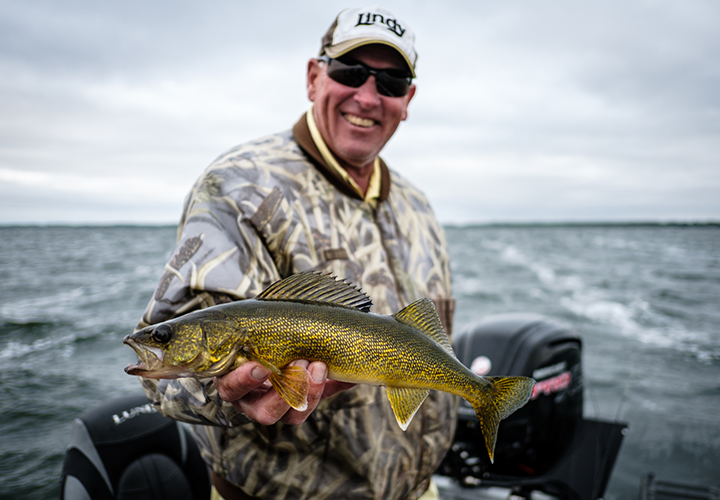 Conditions on the lake would moderate throughout the day on Sunday, but not before Mother Nature blew a breath of optimism in our direction. Mother's kiss on the cheek, woke me up to the idea that for the first time this month, it finally felt like September had actually arrived. The air was crisp, there was a “walleye chop” blowing in from the west-northwest and the surface water temperature was locked in at 66 degrees.
Conditions on the lake would moderate throughout the day on Sunday, but not before Mother Nature blew a breath of optimism in our direction. Mother's kiss on the cheek, woke me up to the idea that for the first time this month, it finally felt like September had actually arrived. The air was crisp, there was a “walleye chop” blowing in from the west-northwest and the surface water temperature was locked in at 66 degrees.
On the heels of a line of overnight storms, the “cold front”, and subsequent dip in water temperatures nibbled away at the effectiveness of trolling presentations and added momentum to the jig and minnow bite. Folks that had been trolling crankbaits were covering a lot of water between strikes, spinners were working, but the pace was noticeably slower than it had been over the past weeks.
Until now, trolling versus jigging presentations have produced similar results. Some of my friends have been fishing using jig and minnow presentations all week long and they’ve been catching plenty of walleyes. For me, spinners have been a better match for the talents of my crew members, they require less finesse and focus on detail. Sunday though, my crew was much more experienced at jig and minnow presentations, so for me, this marked the official start of the jigging season.
It might have been storm related, or maybe it’s because the water is clearing up a little bit, but there was a noticeable decline in fish activity after 11:00 Am. For us, when the sun came out and the wind stopped blowing, walleye strikes were both harder to come by and more difficult to detect. It was not the end of the bite, but I’m glad we had the more fall-like conditions early, giving us a strong head start to the day.
From what I observed, it’s likely that there will soon be heightened emphasis on fishing when the weather is choppy, and the skies are overcast. So too will be the importance of fishing in stained water or lakes with strong algae blooms. At this point, it’s all speculation on my part, so let’s wait to see how it plays out.
In a quick perusal of my facebook pages Sunday evening, I stumbled into images of Crappies that were posted by some friends and acquaintances. Without firsthand information, it’s hard to say for sure, but it looked like MAYBE the cooler weather triggered movements on some of the better panfish lakes in the region. If that’s what happened, I’ll know soon because there will be folks hoping to catch some of them this week and next. That said, the best, most current advice is to continue working the weeds for crappies.
In response to the article, I wrote about Crappies last week, some readers responded.
Bruce Shoden wrote; “I have been getting some (crappies) right on, or just inside the weed edge just before and after sunrise. My bait of choice has been a 1/16th oz tube jig with a small pinched off portion of crawler on it. There is a quick break down to a 30-to-35-foot deep, mid-lake basin type area adjacent to part of the weedy bar and I believe that is a big help. This area seems a bit cooler than the rest of the lake, I had 68.2 degrees this AM, but this bite has been going on for me for about a week.
Feel free to let your readers know what to look for, and what has been working for me.”
Another reader asked to remain anonymous, when he wrote, “I fish a lot and 90% of (the) time is spent chasing crappies. After the spring bite (which was great), I have been striking out all summer. Very frustrating and I cannot figure it out other than they are widely dispersed and have plenty to eat.
I have mainly fished weed edges. Many of the lakes I fish (mostly smaller, northern Itasca) have strong populations of crappies. About 2 weeks ago something changed I started catching fish all over the deeper locations, 24 to 30 feet deep. The fish were scattered in tiny groups of 3 to 4 and many times, even single fish.
Sometimes they were on the bottom, sometimes they were halfway down and other times just under the surface. These fish were well off the weed line roaming deeper water. I started only fishing at dark (not sundown). And they were still biting when I would head out at 10pm. This particular lake has a muddy bottom and is full of zoo plankton to the point where your whole screen is full. They come up from the bottom after dark and I’m sure that is why they are out there. Just passing on an observation from the field.”
In past articles you’ll find references to the clouds of plankton that the unnamed reader mentioned. The death cloud, I’ve called it, is a period when nothing happens. It typically occurs after panfish or perch are done feeding for the evening and marks the end of most fishing trips, at least for me. It’s been 40 years since I can recall staying on the lake until past dark to fish for panfish. But I do have an anecdotal account that aligns with his observations.
When I still lived in the Twin Cities, my day and me would fish one of the better crappie lakes in the south metro area. We’d discovered that there was a time every day when “evening bite” ran its course and all of the other anglers would leave the lake. Without anything better to do at the time, we stayed, waiting an hour or more for the next wave of crappie action to begin. The lull between the evening bite and the after dark bite was intense, there were few, if any strikes during that hour long period. But it was usually worth waiting for that later run of fish and I think this sounds like the pattern our fellow angler has tapped into.
I recall a similar event that occurred up here, on a popular Cass Lake area crappie fishery. My crew and me had been chasing crappies that were suspended over deep water. The action was decent, but we were not “filled out” and decided to fish until past sunset. The death cloud began emerging and as it did, crappies rose higher and higher in the water column. Before we were finished, dipping the jigs over the side of my boat, 3 to 6 inches below the surface was the only way to get a strike.
Daphnia, one of the critters that make up that cloud of plankton are known to be an important food source for panfish. I recall one of the DNR Biologists, Don Pereira perhaps, reporting at one of our panfish workgroup meetings that studies have shown crappies could select and feed on certain, specific, aquatic plankton. So, I agree with our fellow angler when he says; “They come up from the bottom after dark and I’m sure that is why they are out there.”
If you’ve followed these reports for a while, then you already know that crappies will soon become an important part of my daily life. I’ll keep you up to speed as developments develop but let me leave you with this.
The only event that anxious fall crappie anglers need, I think, is for water temperatures to drop a little more. When shallow weeds die off and the crappie’s food sources are forced out of the shallow vegetation, into open water, the paper mouths will follow. So, when you’re practicing your “Rainbow Fish Meditation”, conjure up the image of a slow-but-steady decline in surface water temperatures. Yes, picture that, I think it should do the trick! ![]() — Jeff Sundin 218-245-9858 or EMAIL
— Jeff Sundin 218-245-9858 or EMAIL
 Jeff Sundin "Treat Perch Like Walleyes and Catch More" September 16, 2022
Jeff Sundin "Treat Perch Like Walleyes and Catch More" September 16, 2022
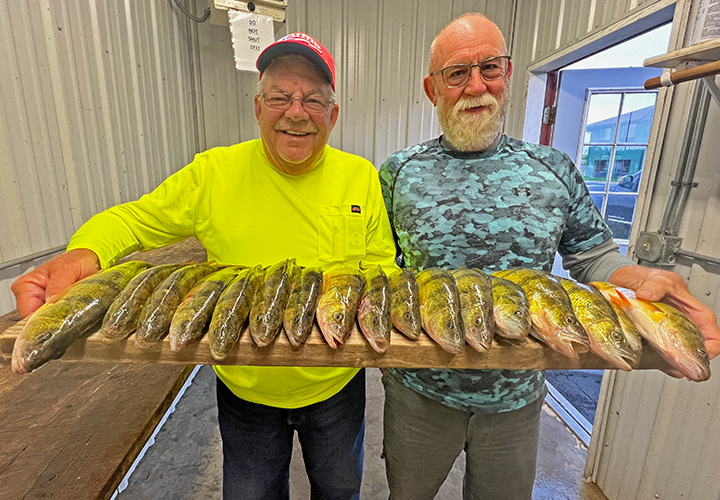 It’s been a very busy couple of weeks and that’s forced to pick and choose which topics to cover using my limited writing time during the wee hours of morning. One topic, perch fishing, has been under-covered lately, so today, I’m devoting my limited morning time to share a few observations.
It’s been a very busy couple of weeks and that’s forced to pick and choose which topics to cover using my limited writing time during the wee hours of morning. One topic, perch fishing, has been under-covered lately, so today, I’m devoting my limited morning time to share a few observations.
Finding larger perch, 10 inches or better, has been easy this summer. But finding those fish in great numbers has been a real struggle, at least for me. Most days, my customers can count on catching 8 to 12 jumbos mixed in with our walleye catch. The one notable exception is that when I target perch, we catch less instead of more. I was headed down that path again yesterday until I swerved into one possible remedy; stop treating the perch like perch and start treating them more like walleyes.
My pal Keith Eberhardt doesn’t really need to fish with me, he can find plenty of fish on his own. But, he and Diane, his wife have taken a moderate liking to me and a couple of times every season, hire me to help entertain certain friends and family members. Greg, Keith’s buddy loves to fish for perch and that’s how I found myself in the hot seat yesterday, searching for jumbos at a time when I have been struggling to catch many of them.
Keith’s inquiry about fishing a lake where we’ve caught perch in the past made me think. The medium, 2500-acre size lake has treated us well in the past and even if the perch are challenging, it won’t any harder than the rest of the places I’ve fished lately. So, why not spend a day, really going hard after the perch on the smaller lake and forget about fighting the waves any of the large, perch factory lakes in the area.
When we arrived at the landing, the surface water temperature was 66 degrees. By the time we were in the middle of the main lake, the thermometer settled in between 67 to 68 degrees. The sky was grey, there was a chop on the water, conditions appeared to be favorable for a great outing.
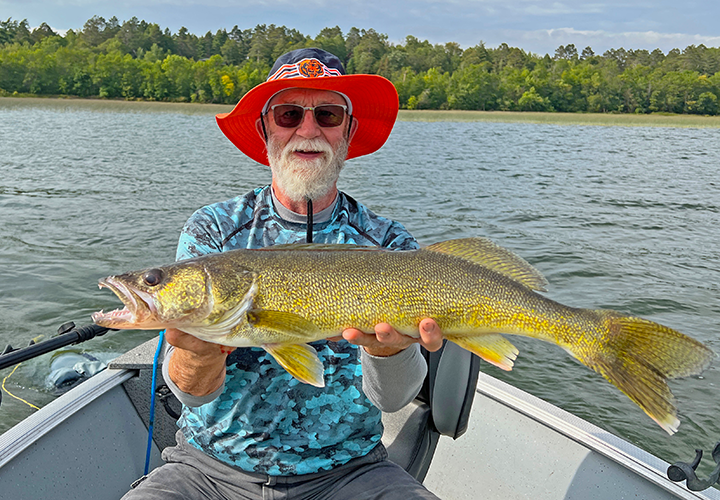 At our first stop, we trolled spinners over the tops of shallow weeds until we caught our first keeper. Then we stopped, pulled out the jigging rods and started poking around with a jig and minnow. That’s standard operating procedure for me, first use spinners to search, then locate and then pinpoint the fish with jigs for maximum efficiency. And it worked, for 2 more fish, then the action stopped. Okay, I’m on the right track, I think. So, we moved to another spot and tried again, and this time the plan worked for about 3 fish, then the action stopped again.
At our first stop, we trolled spinners over the tops of shallow weeds until we caught our first keeper. Then we stopped, pulled out the jigging rods and started poking around with a jig and minnow. That’s standard operating procedure for me, first use spinners to search, then locate and then pinpoint the fish with jigs for maximum efficiency. And it worked, for 2 more fish, then the action stopped. Okay, I’m on the right track, I think. So, we moved to another spot and tried again, and this time the plan worked for about 3 fish, then the action stopped again.
“Reel ‘em boys, lets go try another spot”, I said. We headed for a cabbage bed on the breeziest shoreline I could find and began trolling with spinners. We picked up a keeper, then another one and then one more. So, we stopped, pulled out the jigging rods and started poking around with a jig and minnow. That’s standard operating procedure right, search, locate and then pinpoint, same trick every time, always works; just not today.
After the jig and minnow bite fizzled out on us again, I developed a new attitude, that led to a new “pattern”. Troll the shoreline with spinners once and if I find a couple of fish, turn around and make one more pass to see if there are more, most of the time there was not. Every spot we found turned into a 1 hit wonder, or at least that’s the way it seemed. We could catch a couple of good ones almost everywhere, but never did find the perch motherlode like we have often done in the past.
Scattered fish, spread out horizontally has been the theme of various fishing reports all summer long, but mostly about walleye and crappie. High water levels, abundant vegetation and massive supplies of baitfish may just all be adding up to a pattern that applies across the board, to all species of fish in our region. Maybe the fish just have so many options that they don’t need to stack up in any one location. The bigger fish, loaners by nature, simply stake out a territory and feed at will. They stay under the radar of anglers who are looking for big schools of fish instead of the singles and doubles that we’ve been catching.
It's just a theory, and I know that you have your own ideas. But for me, using this trolling the whole shoreline approach worked a lot better than what I was doing before. We did not catch a 2-man limit, the total harvest for Greg and Keith was 22 fish. But the average size was great, except for 1 fish that measured 9-7/8 inches, none were below 10 inches, and most were above 11 inches; that’s a respectable showing.
There were some “bonus fish” too, as you can see in the photo above right, Greg caught a pretty nice walleye. Greg's 27-inch fish, he says was his personal best walleye. That, along with other small perch, rock bass and numerous northern pike catches kept us busy all day long, it was a good day.
There are correlations between the behavior these perch exhibited and the crappies we’ve been searching for lately too. So, over the next few days, I’ll be looking into that some more, sharing whatever I learn as soon as possible. And it’s been a pretty good week of walleye fishing, so I’ll catch you up on the rest of the fishing we’ve done this week too, as soon as time allows.
If you’re headed up to fish this weekend, good luck out there! ![]() — Jeff Sundin 218-245-9858 or EMAIL
— Jeff Sundin 218-245-9858 or EMAIL
 Jeff Sundin "Where Have All The Crappies Gone?" September 13, 2022
Jeff Sundin "Where Have All The Crappies Gone?" September 13, 2022
Yesterday, I promised an update about if and where I might find crappies with Dick and Paul on their final day of the 2022 fall trip. Either that report piqued folks’ interest, or else it was a gigantic coincidence that last night I had a 4-person text rotation going on at the same time. The subject, common to all 4 simultaneous messages pertained to where crappies could be found and caught right now.
On Monday, I was kind of excited by the weather forecast, I hoped that the nice dip in the overnight air temperatures might push some fish out of the shallows and into early fall spots. But when we arrived at the lake, surface temperature readings were 69 to 70 degrees.
I still wanted to at least rule out the open water spots, so we searched some of the classic early fall crappie spots on what can be a very good crappie lake. We cruised the shorelines, scanning deeper water hoping to find them on steep breaklines located close to shore, or adjacent to weedy flats. We found few signs of life and the fish we did see, were walleyes, not crappies, I think. Like me, friends around the region were out and about, checking typical fall locations on their favorite lakes too, they all reported similar findings.
So, where were they? The simple answer is “in the weeds”, and that’s where they have been on every lake that’s had any decent crappie bite that I know about. But the truth is, I’m having a hard time proving it because they don’t want to bite very well. The only crappie we caught on Monday came out of 6 feet of water, from a gap between 2 boat lifts on the inside edge of a cabbage patch. It’s hard for me to believe that there was only 1 fish in that spot, but it was the only 1 we could get to bite.
It's good to know where they are, but the problem is that knowing their location and knowing how to make them bite are 2 completely different things. Crappies are fickle, and they have a propensity for staging short, intense feeding runs during the crepuscular periods. Once they’ve been fed, they can spend the whole day doing nothing.
Do you recall the story I wrote last summer on August 15th, 2021, after the Hippie Chick and I went crappie fishing in the Ely area? Let me jog your memory with this; “Susan was skeptical, but I kept saying that the fish would probably cruise that weed edge at sunset. Luckily, my credibility was saved when at about 7:30 PM, panfish began striking consistently. I cast a 1/16-ounce round head Lindy Jig, tipped with a Bobby Garland 2.25" Baby Shad Swim’R toward the cabbage, let it drop a few feet and “POP”, a nice crappie!”
But it’s September 13th, not August 15th, why aren’t there any crappies moving into classic fall haunts now? My guess is that the lakes don’t know that it’s September 13th, they only know that the weather remains un-seasonally warm, surface water temperatures are still high, and vegetation is lush and green. The succulent vegetation means that the food chains in most lakes are providing crappies with everything they need in the shallows. They already have food, shelter, and comfort, so why should they leave? I don’t think that there’s any reason for them to move deeper.
Sometimes I can get these fish to bite during the day when there’s heavy cloud cover or a stiff breeze. A couple of weeks back, we had a cloudy day with a chop on the lake and casting the jigs and plastics worked well. But yesterday, everything worked against us, the sun was bright, the lake was glass calm, and the fish were at rest. So, the single crappie we caught turned out to be more of a teaser than a reliever.
I think we need some colder weather, that’s what needs to happen. But I’m being careful what I ask for because too much cold, arriving too quickly will make things worse instead of better. A series of frosty nights, followed by moderately warm days would force a nice steady decline in surface temperatures. That will begin killing shallow water weeds and forcing baitfish to the outside edges. Gamefish will follow their food source and the beginning of the true “fall bite” will arrive.
Now I admit that there’s no way that this can be the definitive crappie report. 1st, because I can only visit so many lakes, and 2nd, the last thing most folks who find any good crappie bite will ever do is spill the beans about it, especially to me. So, there could be a few lakes in our region where the migrations have already begun.
A few years back, I wrote about waiting for the fall crappie patterns to emerge on some of my favorite lakes, but it wasn’t happening. When I began seeing pictures of other anglers showing off their crappie catches, it dawned on me that it was the lack of fish, not the weather that created my problem. Once I abandoned those “favored lakes” and took my search into fresh territory, I found both the crappies and the classic fall patterns.
Before any of us can do well catching fish, we must find lakes that offer good odds. So, if you’re waiting for a fall bite that refuses to start up, and you’re seeing images of friends showing off good catches of crappie, you may do well to research some of the other lakes in your area. That’s what I’ve been doing for several years now, and for the most part, it’s paid off.
I may be back on “walleyes-or-die”, duty for several days now, but I’m not so sure about that. I will, whenever I get my next opportunity to test my theory, let you know how it goes.
I already know that if you’re catching crappies, you won’t want folks to know their location, so I won’t ask. However, you don’t have to spill the beans about your favorite spots to offer help your fellow anglers. Simply sharing information about local trends and patterns is helpful too. In fact, I think it’s even better than sharing spots because it encourages folks to do a little bit of their own thinking. Your thoughts and comments are always appreciated, and nothing ever gets shared unless you give permission. Thank You !! ![]() — Jeff Sundin 218-245-9858 or EMAIL
— Jeff Sundin 218-245-9858 or EMAIL
 Lake of the Woods, LOW Tourism September 13, 2022
Lake of the Woods, LOW Tourism September 13, 2022
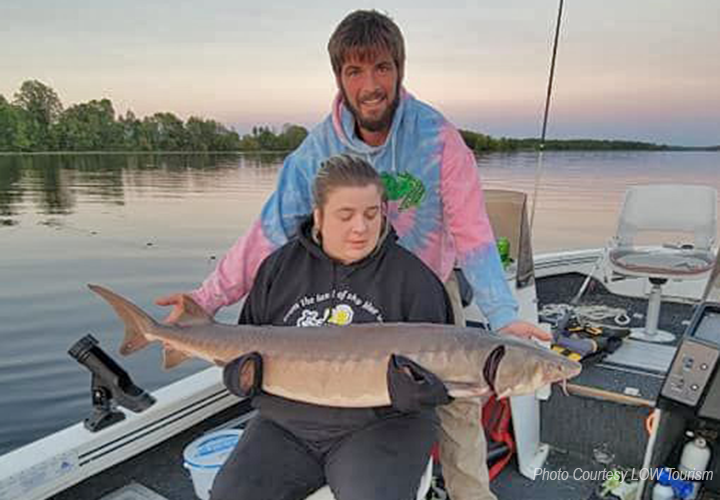 "Another beautiful week of walleye fishing on the south end of Lake of the Woods. Some cool evenings, steam coming off of the water in the morning and the trees just starting to turn colors, The seasons are changing and the fish are biting.
"Another beautiful week of walleye fishing on the south end of Lake of the Woods. Some cool evenings, steam coming off of the water in the morning and the trees just starting to turn colors, The seasons are changing and the fish are biting.
Walleyes are being caught using a few different techniques. Drifting or trolling spinners with crawlers at 1.0 to 1.25 miles per hour is still filling coolers with nice fish.
The second method catching some nice walleyes is trolling crankbaits. Lots of fish of all sizes. Pink UV firetiger, chartreuse, orange and gold are all good colors.
Third, jigs tipped with minnows continue to put a lot of walleyes in the boat. This technique will only get better as water temps continue to decrease. Once you find the fish, anchor up or spot lock and jig.
Reefs, or just off of the reefs near Long and Rocky Points producing good fish. Otherwise, scattered schools of walleyes over the large mud flats.
On the Rainy River, there have been some nice walleyes caught this week as well. The fall run is not hot and heavy yet, but there are some decent walleyes in the river. Stay tuned! With some emerald shiners already in the river along with a good flow of water, anticipation of a strong fall run is expected. Anglers casting shorelines and fishing docks are reporting a nice mixed bag including walleyes, pike, smallmouth bass and some crappies.
Sturgeon are being caught on the Rainy River too, with reports this week of a lot of "average" sized fish with an occasional giant. Colder water will encourage the bite even more.
Lots of beautiful river to fish from the mouth at Wheeler's Point through Baudette east to Birchdale with many boat ramps along the way.
Up at the NW Angle, walleye fishing continues to be very consistent. Jigging and pulling spinners with crawlers are what most anglers are doing to catch walleyes.
North and Northeast of Little Oak over the deep mud of Little Traverse Bay continues to be very good. Lots of fish scattered throughout Little Traverse Bay. Schools of walleyes are also being found on structure, or in some cases, adjacent to structure over mud.
Good numbers of muskies are being caught with a lot of follows. A good figure 8 at the boat catches a lot of fish. Big pike have been in the mix all summer for those fishing for them along with unsuspecting walleye anglers." — Lake of the Woods Tourism, (800) 382-FISH
 Jeff Sundin "Fun with Dick and Paul: Fishing the Fish-Able" September 12, 2022
Jeff Sundin "Fun with Dick and Paul: Fishing the Fish-Able" September 12, 2022
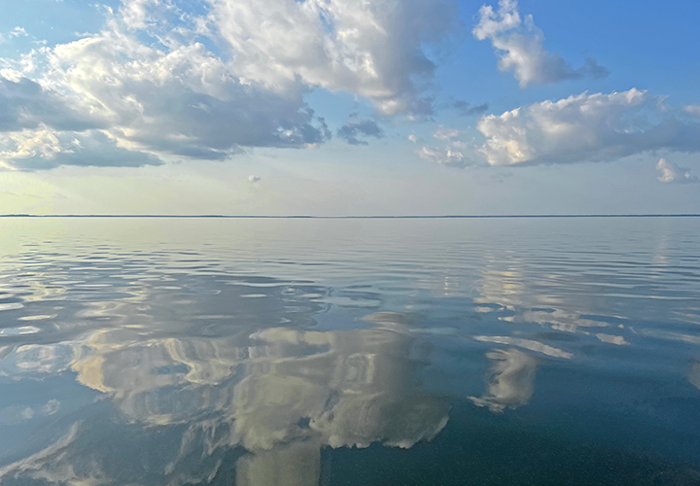 Images of September fishing trips with Dick and Paul usually feature the boys wearing rainsuits, hoodies or sometimes, even parkas. But as the image left reveals, the weather we’ve enjoyed this week only serves to bolster my opinion; the trend toward fall weather patterns kicking in later-than-usual continues to be the case this season. For me, it seems that even color changes in the trees have been slow to arrive.
Images of September fishing trips with Dick and Paul usually feature the boys wearing rainsuits, hoodies or sometimes, even parkas. But as the image left reveals, the weather we’ve enjoyed this week only serves to bolster my opinion; the trend toward fall weather patterns kicking in later-than-usual continues to be the case this season. For me, it seems that even color changes in the trees have been slow to arrive.
Surface temperatures are hovering either side of 70 degrees. Most days, morning temperatures range between 68 and 69, and afternoon temps reach 71, sometimes 72 degrees.
Frequent visitors to the reports might already anticipate me saying that slower-than-average transition into fall weather patterns results in fish being slow to arrive in classic fall locations. Thankfully, there are enough walleyes in Winnie right now that the big lake has provided us with good walleye action. But for the 3 of us, being locked into summertime fishing patterns has meant that we have yet to experience the joy of a truly “hot-fall-bite” for perch, sunfish, or crappies.
Stop, go back, and read that last paragraph again, I didn’t say that panfish are not biting. I said that they are locked into late summer feeding patterns and have been slow to arrive at many of the classic fall locations. So, if you want to catch them, following guidance found in archived fishing reports from July and August, rather than reading the September archives would be a good idea.
On Friday, we took advantage of an opportunity, cloudy skies and a moderate breeze gave me confidence to fish for crappies on a couple of Grand Raids area lakes. We didn’t catch a lot, but the ones we found were in mixed cabbage and coontail plants at water depths of 7 to 10 feet. While we were only marginally successful at catching crappies, the same vegetation held sunfish and bass too; we fared better catching those.
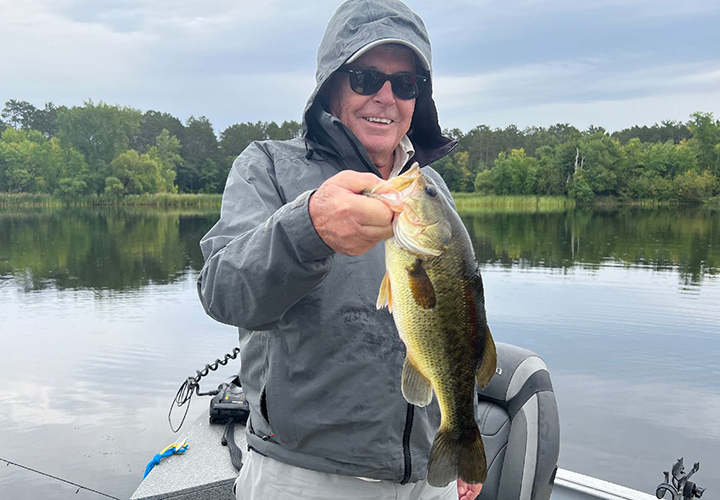 Casting 1/16-ounce jig heads tipped with plastic tails got us started on the crappies, but once the bluegills were discovered, switching to live bait jigs tipped with cut pieces of night crawler worked better on those. When the action stopped, we began exploring for fresh territory by trolling spinners. That worked a little bit too, but I had another goal in mind, so we didn’t stick with it very long.
Casting 1/16-ounce jig heads tipped with plastic tails got us started on the crappies, but once the bluegills were discovered, switching to live bait jigs tipped with cut pieces of night crawler worked better on those. When the action stopped, we began exploring for fresh territory by trolling spinners. That worked a little bit too, but I had another goal in mind, so we didn’t stick with it very long.
Following up on persistent “hot tips” about perch fishing, I decided to take a swing at another spot, so we left the [panfish behind and made a move. Not knowing where exactly to start fishing for them, spinners tipped with medium fatheads would be used as our search tool. The large, shallow flat would take time to cover, but eventually, I’d stumble into the right spot; I thought. About 15 seconds, okay, maybe 30 seconds was the duration of the search. We were reeling them in fast and if they would have been larger, might have ended my search for Jumbos early. Reports about the number of fish were certainly accurate. The problem, for me, was that the fish fell short of reports about their size.
What piqued the boys’ interest at the bait shop, was hearing about 12-to-13-inch perch being caught. But if you actually measure them, which we do, those fish were more like 9 to 11 inches long, with an occasional 11-1/2, the largest we ever caught, thrown in the livewell. The minimum size for us is 10 inches, so measuring the fish and keeping only those, or larger, yielded a total harvest of 20 fish. Not bad, but somewhat disappointing considering the heighted expectations generated by the exaggerated reports.
Yesterday, I took another run at perch, this time on another small, weedy lake and this time, without the benefit of any clouds or wind. In my experience, looking for a “hot-bite” under calm seas and bright sunshine is seldom the formula for perch fishing success and this was no exception. But when you’re trying to check them off your list and fishing under these conditions is your only choice you have, what else are you gonna do? We did pick up 5 more “keeper perch” but abandoned that search and went back to catching and releasing walleyes and pike.
With walleye limits already frozen and ready for the trip home, perch, crappies and maybe sunfish are the targets of choice. I just checked today’s forecast and apparently, we’ll be stuck with another calm and sunny day. So, because the weeds disappointed me yesterday, I’m gonna try the only other approach that I have at my disposal, heading for a dark water lake. Hopefully some nice root beer colored water will mitigate the sunny skies and allow us to have a little action. Whichever way it works out, you’ll be the first to know.
There have already been more than enough reports about fishing on Lake Winnie and they have been accurate. So, I've been letting those reports stand alone, and shying away from adding to the hubbub. Today though I do have a note about northern pike fishing on the big lake.
Last week, I was intentionally trying to get pike to bite for the Nolan’s and it was an uphill battle. This week, they’ve been coming out of the woodwork, and we’ve caught a lot of them while we’ve trolled spinners for walleyes. We’ve caught several of them that were over the protected slot size, ranging from 27 to 32 inches. All have been released except for 1 27-inch fish that I brought home to make coconut pike delight. Not only are fish are growing longer, but they look fatter and healthier than the ones we’ve caught during the summer. It sure looked to me like there’s a migration away from deep water, toward the shoreline beginning.
Maybe this represents a general trend of pike moving toward shallow water to feed, or maybe the uptick was influenced by the recent full moon. We don’t know that for sure, but if you’re an Esox lucius lover, keep this on your radar screen, the fall could be a good one for pike anglers. ![]() — Jeff Sundin 218-245-9858 or EMAIL
— Jeff Sundin 218-245-9858 or EMAIL
 Ely Area, Arrowhead Outdoors Fishing Report September 7, 2022
Ely Area, Arrowhead Outdoors Fishing Report September 7, 2022
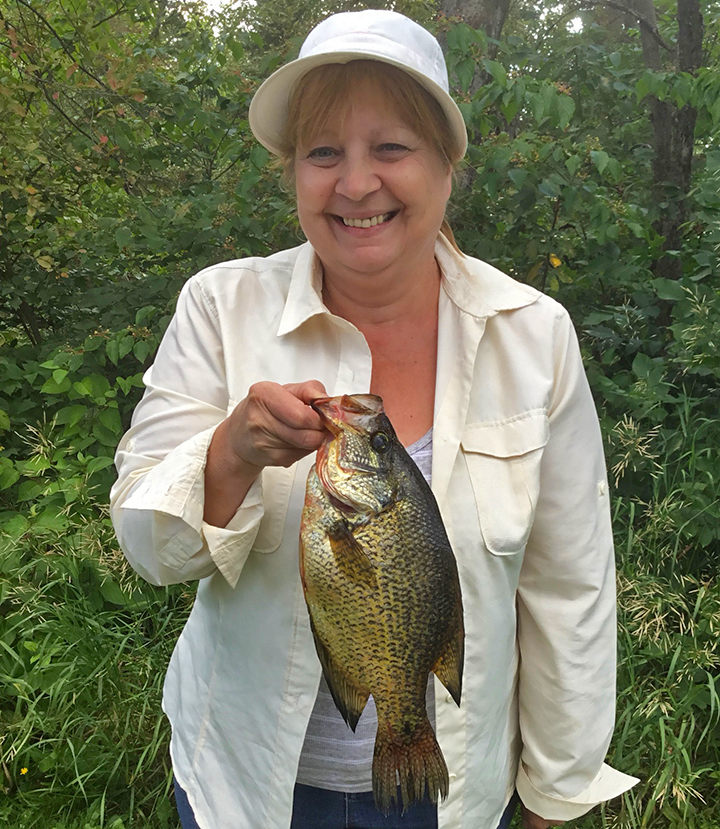 "Walleye - Walleye fishing remains steady for many this last week. Crawlers on spinner rigs and trolling crankbaits remains the best way to catch walleyes. Anglers continue to find walleyes in that 6-12 foot range, working windy shorelines. Gold, brass and orange where the best colors this last week. The minnow bite seems to of cooled off as water temps climbed this last week.
"Walleye - Walleye fishing remains steady for many this last week. Crawlers on spinner rigs and trolling crankbaits remains the best way to catch walleyes. Anglers continue to find walleyes in that 6-12 foot range, working windy shorelines. Gold, brass and orange where the best colors this last week. The minnow bite seems to of cooled off as water temps climbed this last week.
Smallmouth - Smallies continue to transition out to sunken islands, close to deep water, on many of the areas lakes. Out here big minnows either fished on a jig or lindy rigs has been very effective for size and numbers. Humps that top out at 15-20 feet of water have been best. Anglers also continue to find good numbers of smallies still working shorelines, points and current areas. Here spinnerbaits, soft plastics and whopper ploppers remain very effective on aggressive smallies.
Crappie - Crappie fishing has cooled off thanks to the recent cold snap. Anglers are noticing that crappies are starting to school up, just outside large weedbeds and mouths of bays, but getting them to bite has been challenging. Crappie minnows fished under a bobber was the best technique for catching inactive crappies. Pink, white and chartreuse colored jigs were the colors of choice." — Arrowhead Outdoors, 218-365-5358
 Lake of the Woods, Border View Lodge September 7, 2022
Lake of the Woods, Border View Lodge September 7, 2022
"Strong winds last week have made it tough to get around and try different spots. But the mud in little traverse bay in 30 feet has been putting out fish for us still.
Down rigging and spinner fishing with a crawler are the go-to methods in that area. For bigger fish, we are targeting deeper mud on Big Traverse in 33 to 37 feet of water with success. We are finding nice keepers mixed in with the big fish as well. Using plugs, we are having success on a variety of colors — but anything that was primarily white or something with purple seemed to work well. Our spinners as almost always were most productive with a gold blade." — 1-800-776-3474 Border View Lodge
 Lake of the Woods, LOW Tourism September 6, 2022
Lake of the Woods, LOW Tourism September 6, 2022
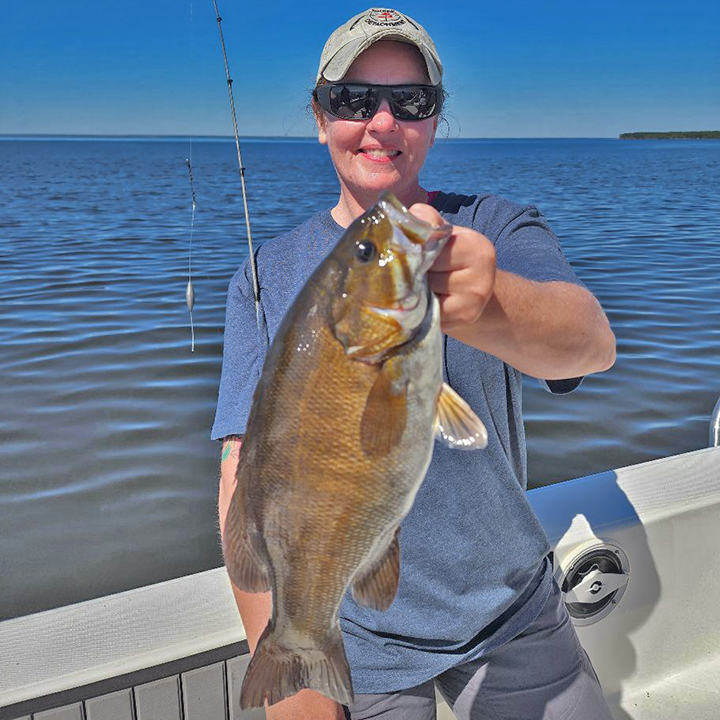 "Walleye fishing has been great all summer, and continues to be strong on the south end of Lake of the Woods. As we transition into fall, lake levels continue to drop, all boat ramps are open, and both lodge docks and fshing charters are available!
"Walleye fishing has been great all summer, and continues to be strong on the south end of Lake of the Woods. As we transition into fall, lake levels continue to drop, all boat ramps are open, and both lodge docks and fshing charters are available!
Last week, the annual "Pay It Forward" event hosted 80 U.S. service veterans who fished on board a variety of Lake of the Woods charter boats. Across the board, all of the participating charter captains delivered their crews back to the docks with limits of fresgly caught walleye in hand.
Walleyes were caught using a few different techniques. Most popular was drifting or trolling spinners at speeds of 1.0 to 1.25 mph. Use a 2 ounce weight, paired with a 2 or 3 hook, snelled crawler harness. Hammered gold, with glow red and glow white were the spinner blade colors of choice.
The second method is trolling crankbaits and these caught lots of fish, and of all sizes. Pink UV firetiger, chartreuse, orange and gold are all good colors.
Third, jigs tipped with minnows continue to put a lot of walleyes in the boat. Anchor up or spot lock and jig over the side or if low wind, drift and jig.
On the Rainy River, walleye anglers are catching some nice walleyes already. Casting shorelines for smallmouth bass and pike is always a good option too for those who like to mix it up and there were some big sturgeon caught this week on the Rainy as well.
Anglers are optimistic for a great fall run as there is good current. Also good bait in the river already with anticipation of shiners starting to enter from the lake soon. As colder water temps arrive, they will almost certainly help the bite, it should only get better from here. There are 42 miles of navigable Rainy River from the mouth at Wheeler's Point through Baudette east to Birchdale with many boat ramps along the way.
Up at the NW Angle, walleye fishing is excellent. Jigging and pulling spinners with crawlers are both very successful methods.
North and Northeast of Little Oak in the deep mud of Little Traverse Bay. Lots of open water to fish with scattered small schools of walleyes and saugers. Other areas adjacent to rock piles, over open mud, along shoreline structure holding fish as well.
It has been a great year for muskies and as water cools, it should get even better. A lot of big pike being caught by walleye anglers, most likely feeding on small walleyes and saugers." — Lake of the Woods Tourism, (800) 382-FISH
 Jeff Sundin "Spinning the Spin-Able and Jigging the Jig-Able" September 2, 2022
Jeff Sundin "Spinning the Spin-Able and Jigging the Jig-Able" September 2, 2022
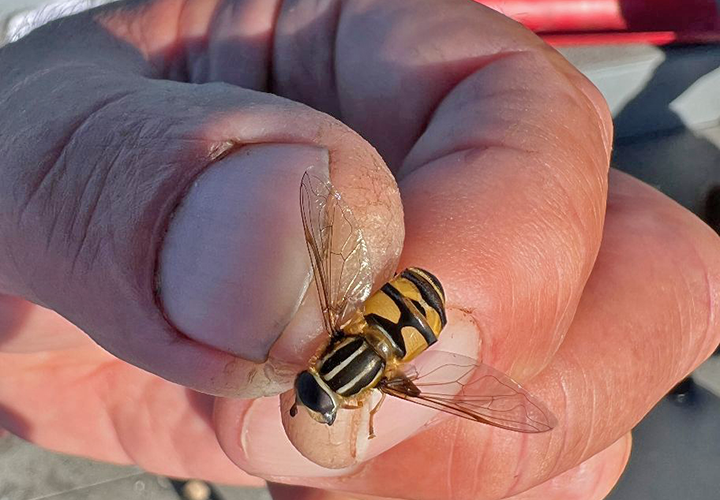 "On Thursday, Rand Olson wrote, “Hey! As much as we all love the summer bite, we turn the page now to September and embedded memories of a cold water, and the frisky walleye attacks on jig/minnow combinations that occur when we put our jackets back on, leaves turn color on and the water temp hovers between 50-55 degrees. We are currently around 70 degrees, so if you would be so kind, please lead us in a water temp countdown, it is fall tradition.”
"On Thursday, Rand Olson wrote, “Hey! As much as we all love the summer bite, we turn the page now to September and embedded memories of a cold water, and the frisky walleye attacks on jig/minnow combinations that occur when we put our jackets back on, leaves turn color on and the water temp hovers between 50-55 degrees. We are currently around 70 degrees, so if you would be so kind, please lead us in a water temp countdown, it is fall tradition.”
Rand, Thanks for the note and you’re right, following the transition between summer and fall fishing patterns is a tradition. So, of course, I’ll be happy to provide details about surface water temperatures and report on trends that will affect the timing of the “fall bite”. Ironically, surface water temperatures went the other way on Thursday, reaching 76 degrees in some of the areas we fished on Lake Winnie.
I remember years when the calendar page turned over to September and the weather outside turned to “September” too. I can recall more than a few days of fishing with snowflakes blowing into my face, in September, well before the leaves were fallen from the trees.
Yesterday, September 1, 2022, the only “flakes” blowing into my face were hoverflies from a hatch more massive than anything I can remember seeing, they’ve been everywhere! The slow moving, bee-like insects, along with a half dozen other kind of bugs hatching, have provided support for the notion that summer fishing patterns will be sticking around, at least for a little while.
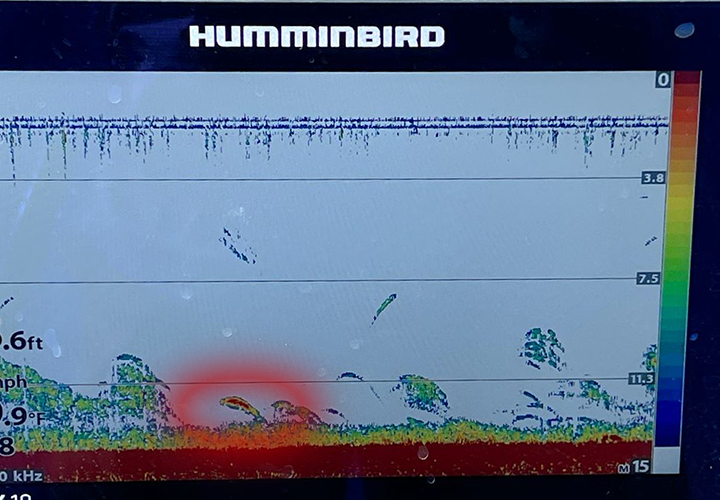 Today, trolling presentations, like the spinner and minnow method we hear about over most of the summer, are still the best bet for most species of fish. Wiggle worming, jigs tipped with plastic action tails and trolling crankbaits are presentations that should also be kept in mind, especially when you believe that you’ve located fish and they won’t respond to your presentation of choice. Last week, I wrote about an experience on a Grand Rapids area lake and how “fickle” the fish in were. Figuring out which presentation each of the species preferred was the only way that we were able to gather a respectable larder.
Today, trolling presentations, like the spinner and minnow method we hear about over most of the summer, are still the best bet for most species of fish. Wiggle worming, jigs tipped with plastic action tails and trolling crankbaits are presentations that should also be kept in mind, especially when you believe that you’ve located fish and they won’t respond to your presentation of choice. Last week, I wrote about an experience on a Grand Rapids area lake and how “fickle” the fish in were. Figuring out which presentation each of the species preferred was the only way that we were able to gather a respectable larder.
That’s not to say that the jig and minnow pattern we’re all looking forward too won’t work. When the wind blows, and fish go on feeding binges in shallow water, jigs and minnows are working already. Even on calm days jigs will catch fish, just not as many as the trolling patterns will, in my opinion.
On Wednesday, we encountered a group of 3 fishermen who were moving slow, casting and retrieving jig and minnow combinations in the same area we were fishing. “Are the jigs working for you guys,” I asked? Not really, the driver replied. Ironically, the next thing that happened is that in the middle of our conversation about how jigs weren’t working, he caught a walleye.
Aside from the discussion about water temperature, I have another thought about why trolling is better than jigging right now. Look at the image of my graph, taken at the time of that encounter. There are pods of baitfish, a couple of small gamefish and 1 nice looking mark that was likely a walleye. That image repeated itself over and over along a mile long stretch of shoreline on Winnie’s west side. There were a few larger schools of walleye, but for the most part, it was 1 fish here, 2 fish there, and so on.
When the fish are spread out horizontally, trolling spinners may not necessarily be a better way to make fish strike, but it is a better way to cover more water. The more water we cover, the more fish we encounter and that in turn, leads to more fish tugging on the line.
For all I know, we could have caught every single fish we encountered by moving slower and casting jigs and minnows. It just would have taken a lot longer to travel from one fish to the next to implement the plan.
Falling water temperatures and everything that comes along with them, have a way of concentrating fish. There comes a time when there’s less space between fish and covering miles of water is less important. Jig and minnow combinations overtake trolling presentations in terms of efficiency, not necessarily effectiveness.
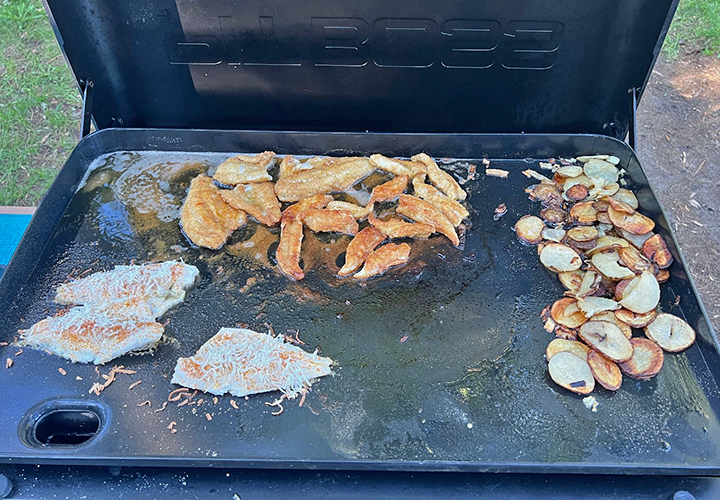 My friend Jake Premo, one of the better guides on Winnie’s west side does not troll spinners, in fact, Jake has been doing nothing but jigging. Even yesterday when water temperatures were warming, Jake and his crew were jigging. I can’t make any comparison to our success rates, but I did note that they were catching fish. I think in part because Jake was trolling as fast, or almost as fast as we were while they are jigging. Faster speeds and aggressive snap or rip-jigging may be all it takes to equalize the efficiency of the 2 presentations.
My friend Jake Premo, one of the better guides on Winnie’s west side does not troll spinners, in fact, Jake has been doing nothing but jigging. Even yesterday when water temperatures were warming, Jake and his crew were jigging. I can’t make any comparison to our success rates, but I did note that they were catching fish. I think in part because Jake was trolling as fast, or almost as fast as we were while they are jigging. Faster speeds and aggressive snap or rip-jigging may be all it takes to equalize the efficiency of the 2 presentations.
It takes endurance to fish fast with jigs and minnows. For me and many of my customers, aggressive jigging styles are getting harder to do physically. It’s less stressful on one’s body to troll spinners, sometimes even with the rod in a rod holder and allowing the fish top “catch us.”So, as long as it works, this presentation gets the nod.
In recent years, summer weather has lingered longer into September. I’ve even said that it seems like October is the new September, that’s when the surface water dips into ideal range and the hot, jig and minnow bite really kicks in. One of these days, the seasonal weather pattern will probably change, it always does. In the meantime, responding to Mother Nature’s quirks and whims is about the best we can do.
Like I said, I’ll be tracking weather trends and reporting about when the jig and minnow bite hits maximum efficiency. But in the meantime, enjoy the fabulous weather over your Labor Day hooliday weekend. And, whatever you do, don’t shy away from jigging, try it, even when the water is warm. There will certainly be times when fish are concentrated enough to make it a great idea. ![]() — Jeff Sundin 218-245-9858 or EMAIL
— Jeff Sundin 218-245-9858 or EMAIL
 Wired2Fish "Fishing for Late Summer Crappies | What it Looks Like Underwater"
Wired2Fish "Fishing for Late Summer Crappies | What it Looks Like Underwater"
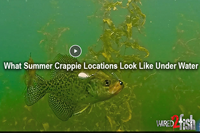 "Locating summer crappie can be a daunting task due to their nomadic nature. Wired2fish staff McKeon Roberts discusses how you can shortcut locating summer crappies by highlighting what to look for as well as an in-depth look at a variety of baits to help you cover water and stay on the fish.
"Locating summer crappie can be a daunting task due to their nomadic nature. Wired2fish staff McKeon Roberts discusses how you can shortcut locating summer crappies by highlighting what to look for as well as an in-depth look at a variety of baits to help you cover water and stay on the fish.
McKeon talks about transition areas that are magnets for summer crappie. Namely finding thick, healthy, outer weedlines adjacent to fertile bays that have access to deep water. Weeds are the key here, and crappies will roam them like underwater corridors. These weed beds can often be massive, which makes intercepting roaming crappies a bit of a challenge.
Two things to consider when locating crappie in weeds are, the ability to cover water and fish slow while staying snag-free in and around thick vegetation. McKeon goes over a variety of baits suited for all anglers, that ..." View Video to Learn More >> Fishing for Summer Crappies | What it Looks Like Underwater